The Global Landscape on Vaccine ID Passports Part 4: BLOCKCHAINED
Let’s get right to it because there’s a lot to cover. Part 3 tackled the key implementers of the digital identity being assembled through the vaccine id passports, revealing the true agenda. Part 2 broke down the who, what, when, where, why, and how. It’s good to understand what’s at stake and who’s behind it, before diving into part 4. Blockchained will cover some of the most important aspects of this entire agenda against all of humanity.
This Report Details:
• The QR Code is About Your DATA, Your DNA, and Your BODY
• BLOCKCHAINED
• Wallets, Crypto, Central Bank Digital Currency (CBDC), and The Banks of The Future
• Artificial Intelligence and Augmented Humans
• Recap List of all Names and Organizations Covered in Parts 3 & 4
• Suggestions and Solutions
In short, once you have submitted to getting your digital identity QR code, you have opened the door for them. Think of it like WordPress that uses an endless amount of plugins to build your perfect site. You have your smartphone as the device, the QR code is the tool, and all of the individual apps and institutions hook right in to your QR code. You’ve now linked your health records, injection records, bank account, financial loans and assets, shopping, events, travel, you name it! They are using the blockchain framework to run, sync, share, and distribute, all of that data under the guise of “convenience” for you. Some will be centralized, some decentralized, but at the end of the day your data is out there as a means for them to control you, remove all privacy, and be used for their AI agenda. This only happens if you take that first step. Whether it’s your bank requesting you create a digital ID, your state for a driver’s license, institutions for a “vaccine ID passport,” or whomever makes the request or demand, don’t open that door.
There is a list of solutions for how to combat this at the end of the report. Don’t miss it!
A quick peek at what the World Economic Forum predicts for the world in 2030:
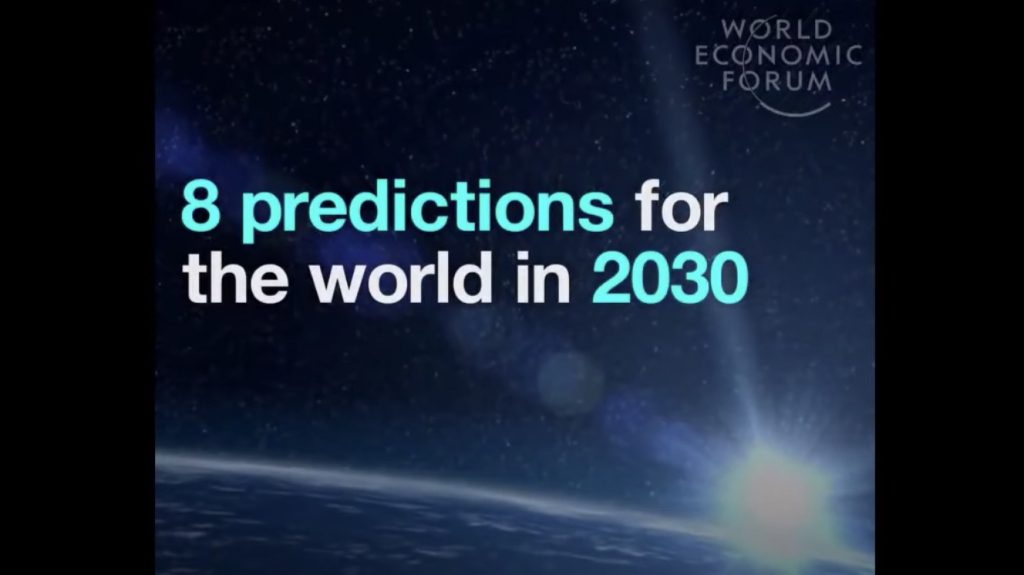
Normalization of QR Codes To Access Your Data, Your DNA, and Your BODY

A QR code is not just a flashy little symbol that gets you a free donut after accumulating points, a convenient little app on your phone to prove you’ve received the Covid-19 injection that allows you access into a concert, or a quick way to make a purchase, though they want everyone to believe that’s the sole purpose. It is far more than that, and most people can’t even begin to understand the repercussions of its use and how they have weaponized it. This goes beyond the Covid injection data collection scheme for controlling humans across a smart grid, and enters straight into the eugenicists’ dimension.
The QR code system was invented in 1994 by Masahiro Hara from the Japanese company Denso Wave. It was approved in December 2011 by GS1, an international standardization organization, as a standard for mobile phones, and by the International Standardization Organization (ISO) in 2020. Now days, everyone is seeing and utilizing the QR code, not only for vaccine id passports, but for shopping, menus at restaurants, special programs at food chains, and just about everywhere. They’ve done a great job of normalizing a machine-readable visual symbol that contains data for identifiers, locations, tracking points, etc. The problem is, a QR code can only handle up to 7,089 characters, so in order to store a person’s entire life data, as the globalists wish to do, they need to link it through a blockchain platform.
Up until more recently, internet protocol version 4 (IPv4) didn’t have enough IPs in the world to accomplish this task, but with the new IPv6, there will be no shortage of IPs to make this all integrate effectively. This will allow for every single human, computer, cell phone, smart product, IoT sensors, and any other device that connects to the internet to have a numerical IP address to communicate with other devices, accomplishing their smart grid goal. Throw 5G into the mix, and we’re off to the races!
The “human barcode” and “microchipping” dystopian technology on human beings have long been censored and dismissed by mainstream news as conspiracy theory for years, despite the fact that the science and products exist, in some locations have already been implemented, and MIT has even published a study about it – funded by the Gates Foundation, of course. Even the Smithsonian couldn’t resist covering MIT’s study on how a “spiky patch” could invisibly record vaccination history under the skin, explaining that “the human body is an extraordinary record keeper.”
Here’s what’s interesting about this particular method – they liken this “tattoo-esque” technology of microneedles that inject patterns of invisible nanoparticles under the skin, as QR codes that can be scanned by smartphones.
An NIH study from 2012 shows how they carried out research to determine the best way to identify and store DNA data, which revealed that the QR code was found to have the largest coding capacity and high compression ratio, allowing them to convert a DNA sequence to and from a QR code. They then constructed a web server for biologists to utilize QR codes in practical DNA barcoding applications. In 2021, the National Science Foundation raved about the next-generation sequencing technologies that have revolutionized genetic data, by allowing them to store the data in a QR code so they can simply scan a specimen and extract the data, which streamlines data collection.
What’s the next step? Now that they’ve managed to store DNA data into QR codes, putting that data onto a blockchain platform is the next best thing for scientists. Just imagine the millions of people who have submitted their DNA through Ancestry, 23andMe, and countless other eugenicist-owned organizations, such as George Church’s Nebula Genomics. Not that they are all putting the data on the blockchain yet, but Church and others certainly are. So where is this heading, and what is the QR code really about?

“Genomic big data is projected to outgrow video and text data within the next few years.” – Nebula Genomics
Molecular Engineer, Chemist and Geneticist George Church founded Nebula Genomics in 2018. They run whole genome sequencing that decodes 100% of a person’s DNA to “unlock your genetic blueprints.” For just $99 – $299 you can “begin your journey of discovery without risking the privacy of your most personal information” – until he rolls it onto the blockchain. They have partnered with Oasis Labs for “cutting-edge privacy technology” on blockchain. People will surely argue that blockchain is protected and none of these nefarious characters will have access to any of your data. Keep reading.
Why blockchain? What is their goal? Nebula wants to connect people with companies, and give people the opportunity to sell their genetic information that Nebula sequenced, to these companies, in which case people will receive payment in the form of digital tokens, all in the name of science. This isn’t the only company Church owns or co-owns in regards to DNA collections going on the blockchain. More on this below.
Just how far will Church go to achieve being able to create whole genome engineering of human cell lines – to “write DNA and build human (and other) genomes from scratch?” In early 2021, there were warnings going out to all U.S. states regarding China trying to setup Covid testing labs in an attempt to gather DNA and other data on U.S. citizens. Even mainstream media couldn’t shy away from this story. The company, BGI and it’s U.S. subsidiary CGI were approaching city, county, and state officials to sell their supplies and setup full labs. BGI was founded in 1999 as the Beijing Genomics Institute, had participated in the Human Genome Project that Church initiated, and was given a line of credit from state-run China Development Bank and used it to purchase 128 DNA sequencers from Illumina who is a massive producer of DNA sequencers out of California, which was the largest order Illumina had ever received (more on Illumina further down). In 2017, BGI announced the launch of the George Church Institute of Regenesis, in collaboration with Church, who has been a longtime advisor to BGI. Church is the chief scientist of the institute and it’s co-located with the China National GeneBank in Shenzhen. Their plan, announced in 2017, over two years prior to Covid, was to develop technologies in high-density DNA storage, biomanufacturing of natural products, and genome editing for medicine.
In his appearance on the Stephen Colbert show, Church explained how they can read ancient DNA, write it, and edit it with Crisper, and they’ve made 15 edits so far to bring back extinct DNA. For example, he’s been inserting wooly mammoth DNA into elephant skin cells which can then be turned into stem cells and used to produce embryos with the hope of growing them in an artificial womb. “It’s going to be more humane and easier if we can set up hundreds of [embryos] in an incubator and run tests,” says Church.
This isn’t surprising, because in a 2013 interview with the German magazine Der Spiegel, Church said, “you have got a shot at anything where you have the DNA. The limit for finding DNA fragments is probably around a million years.” When asked about the DNA fragments of Neanderthals that scientists have, who existed 30,000 years ago, Church said that the DNA could be assembled into an embryo which could be planted inside a human – a very daring woman. He believes that significant knowledge could be gained from cloning Neanderthals, stating…
“We know that they had a larger cranial size. They could even be more intelligent than us. When the time comes to deal with an epidemic or getting off the planet or whatever, it’s conceivable that their way of thinking could be beneficial.”
Though Church acknowledged ethical and legal dilemma’s, he was quick to point out that “laws can change.” That interview took place in 2013.
Who is Dr. George M. Church, in a nutshell? This barely scratches the surface:
• Professor of genetics at Harvard Medical School and Professor of Health Sciences and Technology at Harvard and MIT
• Founding Core Faculty & Lead, Synthetic Biology at Wyss Institute at Harvard University
• Director of the U.S. Department of Energy Technology Center
• Director of the National Institutes of Health Center of Excellence in Genomic Science
• Developed the first direct genomic sequencing method and first genome sequence in 1984
• Known as the “Godfather” of The Human Genome Project in 1984 and Personal Genome Project in 2005. The U.S. National Academy of Science, NIH and the DOE were all involved in the Human Genome Project, Congress kicked in $2.7 billion to make it happen, and it was made public in 2003.
• Co-authored over 550 publications and holds more than 150 patents
• Co-authored the book ‘Regenesis: How Synthetic Biology Will Reinvent Nature and Ourselves’
• Funded by the Jeffrey Epstein VI Foundation from 2005 – 2007
• Founded Nebula Genomics in 2018
• Co-founder of Veritas Genetics, Editas Medicine, Cambrian Genomics, LS9 which sold to the Renewable Energy Group in 2013, eGenesis, 64x Bio, Gen9, and several other companies.
• Led the project on barcoding the brain, via a $21 million 5-year brain mapping grant under the Machine Intelligence from Cortical Networks program sponsored by the Intelligence Advanced Research Projects Activity. Their goal was to give neurons unique barcodes, linking them across synapses to create maps of their connection through gene sequencing to design computer architectures that could perform tasks that are easy for a brain but out of reach for artificial intelligence.
• In 2008, Church, Bill Gates, and Leena Peltonen from the Wellcome Trust Sanger Institute were all speaking at a genome sciences symposium at the University of Washington. In 2013, George Church was invited to speak at the Wellcome Trust Epigenomics of Common Diseases conference. In 2019, he was the keynote speaker for another Wellcome Trust event on new technologies. At this event, Church gets a chuckle while referring to this image below as his “conflict of interest slide,” and his “thank you slide for organizations that help get our technology out into the real world.”
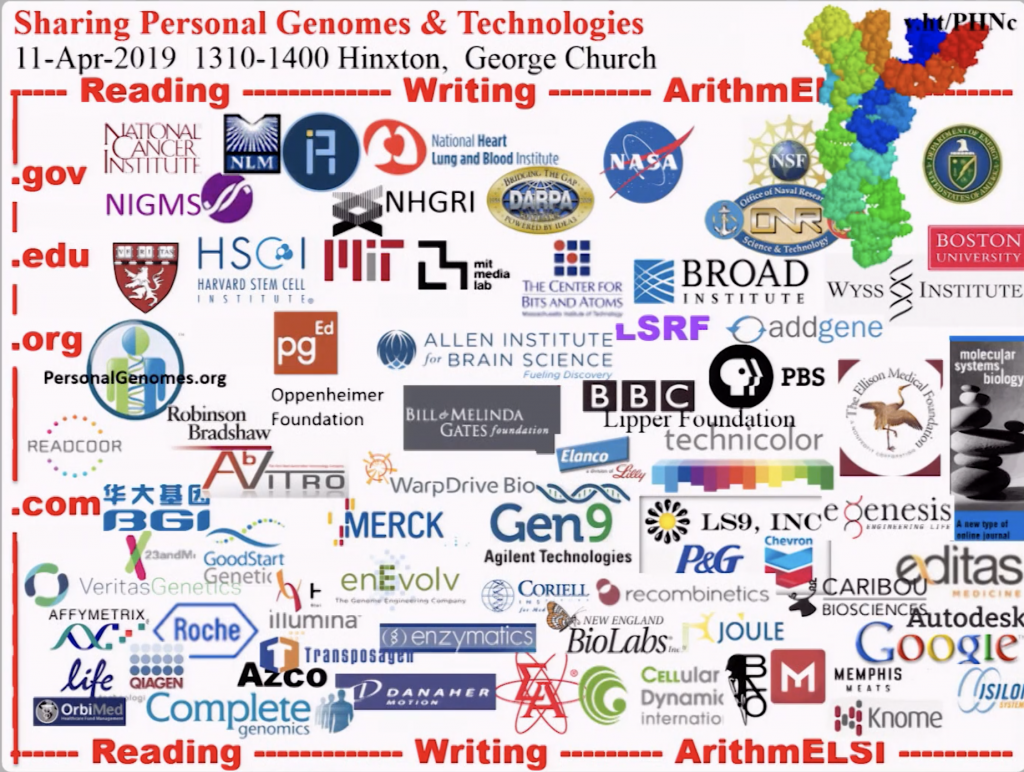
• In 2021, he co-founded HLTH.network (formerly Shivom), a healthcare blockchain that created the world’s first global marketplace for genomic and healthcare data, and operates with the OMX token. According to their site, they state they are the world’s first precision medicine data hub, DNA NFT marketplace, crypto health store, healthcare blockchain focussed journal, and Solana focussed healthcare blockchain ecosystem fund – that’s a lot of firsts. Their mission is to provide the world with a tokenized & inclusive ecosystem that empowers all stakeholders to build a new era of healthcare – “one token for all healthcare blockchain for years to come.”
In order to further normalize gene editing, QR scans of DNA on the blockchain, and transhumanism, in true Hollywood fashion they’ve decided to make a “dramatic series on the dangerous and life-affirming ways the technology can impact the world.” Morgan Freeman and Lori McCreary of Revelations Entertainment, and Jay Firestone of Prodigy Pictures are partnering with George Church. They refer to him as a geneticist and CRISPR pioneer and state that the series will explore “personal and global implications of cutting-edge gene editing and engineering technologies being used in the effort to combat climate change,” and assure everyone that the impact this genetic technology will have on our lives is coming faster than we think. This was just announced in March 2021, so a release date hasn’t been publicized yet.
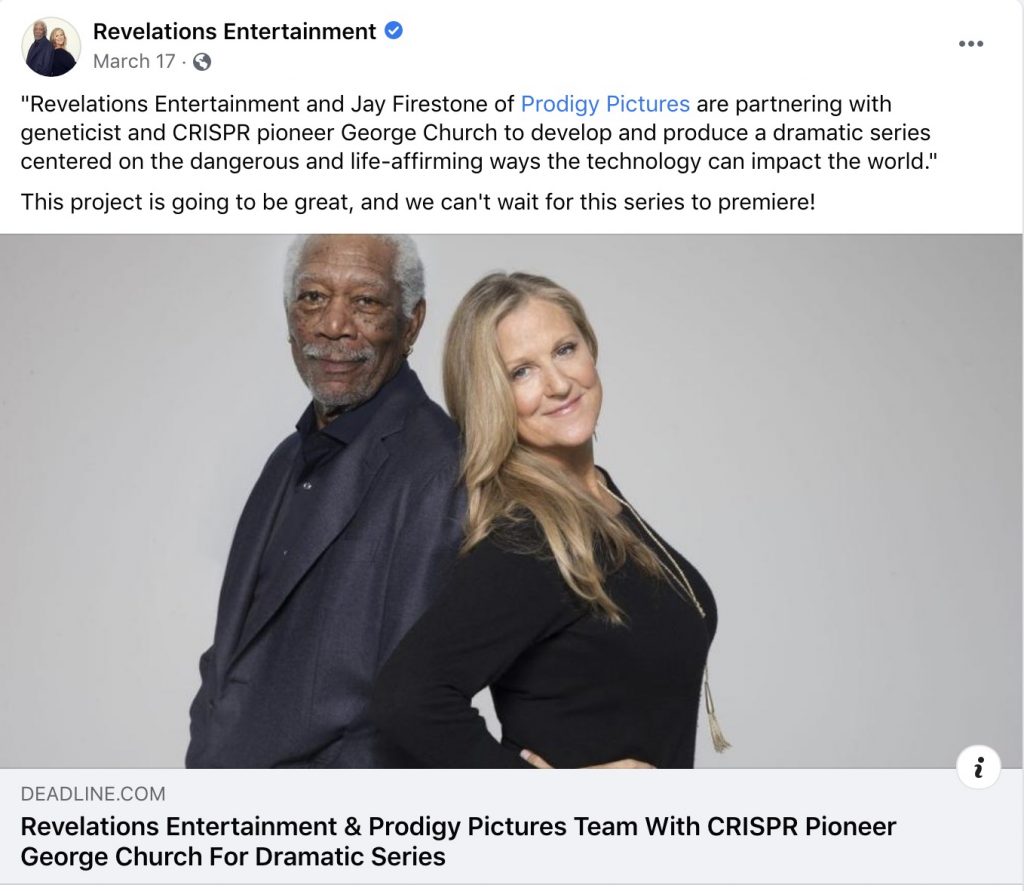
This is why George Church is such a significant player in their future agendas. By utilizing DNA, synthetic biology, QR codes, blockchain, and gene editing, he is paving the wave toward their vision of a transhumanism AI future – and who knows, he may just bring back dinosaurs one day. More on augmented humans and AI further down.
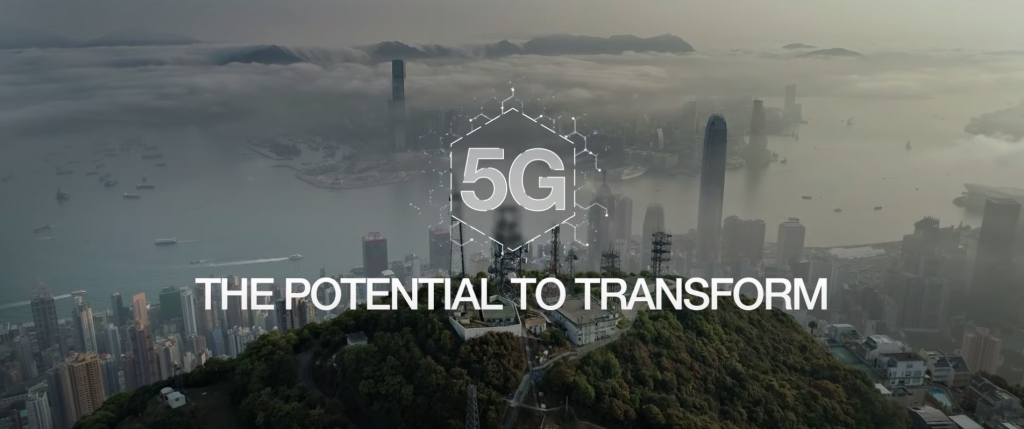
There are roughly 20 billion connected devices today and with 5G they anticipate there will be 50 billion devices connected by 2030, with machines talking to machines. In less than 5 minutes, the World Economic Forum reveals what they foresee for everyone’s future.
How bad do the powers that be want everyone plugged into the “smart grid?” They recently introduced a bill called the Digital Equity Act of 2021, and then stuffed it into the big Infrastructure Investment and Jobs Act that the Senate recently passed, with proposed $2.75 billion in funding. This entire infrastructure bill is about the “smart grid” infrastructure. They’ve already created a website for “Digital Equity” as well. The Act would require the National Telecommunications and Information Administration to establish a “State Digital Equity Capacity Grant Program” and the “Digital Equity Competitive Grant Program” to use your taxpayer dollars to ensure that every American has access to broadband and is plugged into the internet.
It sounds like a wonderful convenience on the surface, unless you understand their grand plan. They state that the purpose of these grants is also to promote the achievement of digital equity, support digital inclusion activities, and build capacity. This promotion is to be a lockstep delivery with every department rolling out the same message, such as agriculture, housing and urban development, education, labor, health and human services, veterans affairs, the federal trade commission, small business administration, and a half dozen others. States will each develop their “State Digital Equity Plan” in collaboration with “stakeholders” to achieve the digital inclusion activities and objectives, and can make sub–grants to those stakeholders.
In July 2021, the National Security Commission on AI organized a Global Emerging Technology Summit, whereby they discussed a multitude of topics, including the fact that the OECD set the standards for broadband and telecommunications infrastructure, “including the development of transparency reporting frameworks for terrorists and violent extremist content online,” in the 5G network rollout.
To simplify, what this “Digital Equity Act” is really about is building the framework to plug everyone into the “smart grid,” while states provide “digital inclusion activities” with statewide instructions on how people must link into their services such as disability aid, social services, unemployment, how to get your digital ID, future housing, and so on, while being surveilled through the new standards they’ve set with broadband and the 5G rollout.
The QR code was never about a free donut or an easier way for people to shop or market products – that was just done to normalize its use and play it off as a “convenience,” just like handy smartphones. The reality is that it’s about controlling the human race by aggregating all data on every human being and object while allowing them full surveillance over your life, and scientists full access into your body. So the next time a restaurant provides a QR code to access their menu, demand an actual menu or leave the restaurant. Stop using the QR codes everywhere you go. Stop swiping your smartphone and playing right into their hand. REFUSE QR CODES.
BLOCKCHAINED

“It’s possible that blockchain could end up being the single, secure token element to certify the authenticity of everything.” –Chad Ballard, Managing Director Head of Core Banking Technology at JPMorgan Chase & Co
The name of the game is to get all human beings and every product onto the blockchain for full traceability, where privacy will no longer exist. Think of the QR code as the middle man and the smartphone as the tool. Blockchain technology can be a bit confusing, so here are some basics on it as well as how tokenization works. Originally created for digital currency transactions, it is now being used for IoT, supply chain tracking, financial services, asset management, identity verification, “smart contracts,” and much more. A distributed ledger blockchain framework allows for the collection of data that is shared and synchronized across multiple sites, countries or institutions.
Most people are familiar with Bitcoin operating on a “Decentralized” blockchain. But don’t worry – the Linux Foundation is covering the “privacy” end of things, as covered in part 3, for all of these new blockchain platforms. The programs and agendas being developed and carried out for full control over humanity, involve Federated, Centralized, and Decentralized systems. There is an excellent chart that breaks this down on page 13 of the World Economic Forum’s 2019 report on ‘Trustworthy Verification of Digital Identities.’ Nearly all of the “systems” being put in place involve utilizing the blockchain framework distributed ledger technology, for governance. Their intention is to create global regulations, laws, and interoperability. No matter how they spin the language to appear as though this is a secure system with privacy for all, those in power will have access to much of the data, and that data/record never goes away – it is permanent.
On page 6 of this report they explain that they expect an entire ecosystem of applications working with a handful of blockchain platforms because “the time is not yet right for a single platform due to commercial sensitivities, distinct views on technology choices, and different perspectives on governance of blockchain networks.”
Their ultimate goal is to have every human being and every product traced, tracked, and surveilled. For example, the Evrythng Product Cloud gives products a digital identity. It creates a twin in the cloud which is linked to an identifier that is embedded into the smart packaging or smart code, making the object interactive with software intelligence that allows it to participate in new applications. Evrythng provides an API gateway called the Blockchain Integration Hub which enables the data to be replicated or collected from different blockchains. In addition to supply chain history and live tracking data, it also hosts metadata on a product that needs to be updated, such as temperature, humidity, or current owner. One can imagine the level of surveillance once all products are tied into the smart grid. Already, there are cities outfitted with street lights that host cameras everywhere people walk, under the guise of protecting everyone from crime or monitoring climate change.
In the World Economic Forum’s (WEF) ‘A Framework for Blockchain Interoperability – 2020,’ they talk about the advancement of the Fourth Industrial Revolution technologies and how blockchain will allow for future supply chain transactions and business processes to be handled by autonomous software agents and IoT.
This short 3-min video by the WEF titled ‘Shaping the Future of Technology Governance: Blockchain and Digital Assets‘ explains how blockchain is already here and the great ways it can be used, and assures everyone that “it’s not really important that you understand how blockchain works.” They are working with over 100 companies and 8 governments on projects.
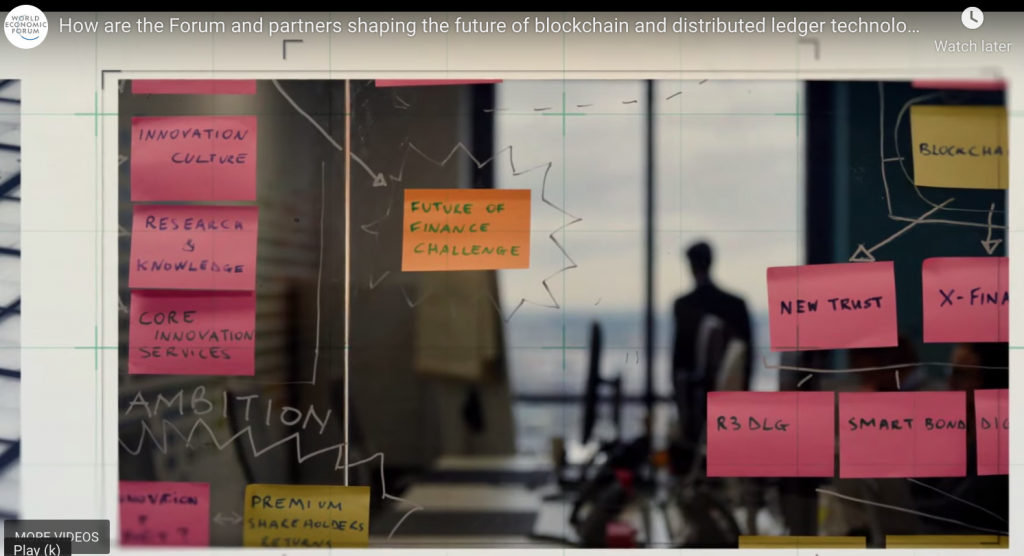
“Blockchain will fundamentally change financial systems in the next 10 to 15 years. A blockchain technology will be applied in many areas because it is about trust, credit, security – the security of data and the privacy of data.” – Jack Ma, Cofounder of ANT group and founder of Alibaba
J.P. Morgan envisions a multi-blockchain world where multiple blockchain networks of multiple protocols will be meshed together due to the rapid evolution of technologies. They do not see a one-blockchain-network world, at least not yet. They themselves recently helped develop technology for the Monetary Authority of Singapore and the Central Bank of Canada to execute cross-currency through a cross-blockchain swap using Hash Time Locked Contracts (HTLC). They are working on a gateway layer that will make it easier to interact with multiple blockchains, and are excited about digital identities, green energy registration and trading, vehicle identity and telematics – all being enabled by blockchain technology for a “multi-blockchain world.”
Accenture, part of the ID2020 group discussed in Part 3, has a lot to say about how blockchain revolutionizes identity management, gives individuals the power to be back in control of their identities, and assures you that you get to decide what identity attributes you share with each organization.
Cloud storage plays a significant role as well. This article explains the comparison between Amazon’s AWS and Microsoft’s Azure. The chart below shows the current competition in this arena.
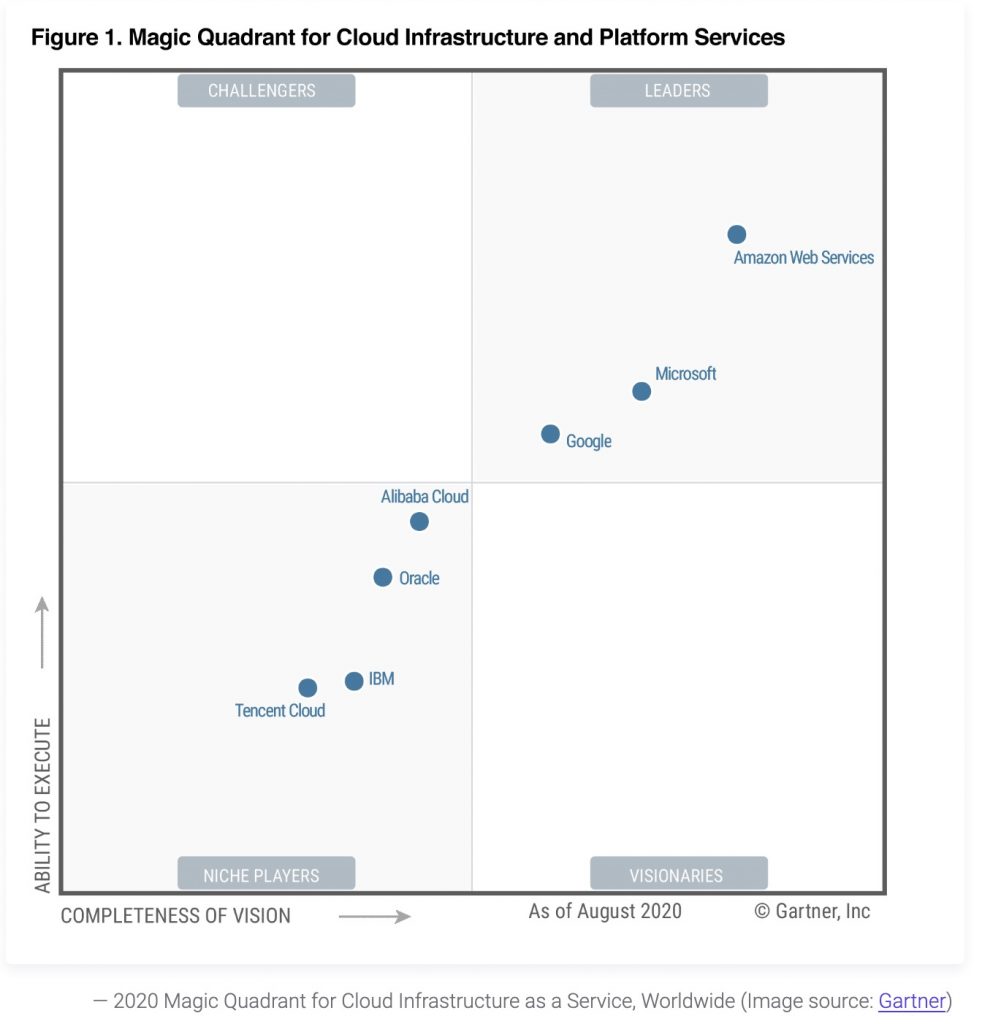
According to the World Economic Forum’s charts from their 2020 report, none of the large technology vendors that support blockchain have launched interoperability solutions except for Microsoft, who is currently working with Nasdaq on a project to create a ledger-agnostic solution. Other large technology firms include IBM, SAP, and Oracle. IBM utilizes Hyperledger Fabric for supported blockchains and IBM MQ for z/OS for hybrid cloud transformation for interoperability with non-blockchain. SAP uses Hyperledger Fabric, MultiChain, and Quorum for supported blockchains and integrates SAP solutions to blockchains via a SAP cloud service and blockchain adapter for interoperability with non-blockchain. Oracle also utilizes Hyperledger Fabric for supported blockchains and REST APIs and Hyperledger SDKs for interoperability with non-blockchain.
The report also shows a chart indicating documented technologies being used for individual blockchain or interoperability solutions. Those are:
AION
ARK
Bitcoin
BTC Relay
Corda
Cosmos
Ethereum
Hyperledger
Hyperledger Quilt
ICON
Interledger
POA
Polkadot
r3 Corda Settler
Ripple
Wanchain
And finally, the report discusses some of the bigger organizations who are focusing on creating standards to drive business model interoperability. Those are:
Belt and Road Initiative Blockchain Alliance
Blockchain Industrial Alliance
Blockchain in Transport Alliance
British Standards Institution
China Electronic Standardization Institute
Digital Container Shipping Association
Enterprise Ethereum Alliance
European Blockchain Partnership
GS1
Institute of Electrical and Electronics Engineers
International Organization for Standardization
Mobility Open Blockchain Initiative (MOBI)
In addition to this, according to a discussion paper on geospatial standardization of distributed ledger technologies by the Open Geospatial Consortium (OGC), their are several groups working on blockchain standardization; International Organization for Standardization (ISO), International Federation of Surveyors (FIG), The World Bank, the International Telecommunication Union (ITU-T), and the FOAM initiative.
Big Moves in Blockchain Already Underway

Below are examples of how the blockchain framework is being used to track, trace, and surveil products and people.
• China launched a major blockchain initiative called the Blockchain-based Services Network (BSN) that created an infrastructure for interconnectivity throughout the mainland, including city governments, companies, individuals, and the Digital Silk Road to connect with China’s trade partners around the globe. The main founding partners are the State Information Center, China Mobile, China Unionpay, and Red Date Technologies. BSN has developed cloud management technology to allow multiplexing compute with cloud providers under BSN’s multi-cloud services already in place, such as Amazon’s AWS, Microsoft Azure, Google Cloud, Baidu Cloud, China Unicom, China Telecom, and China Mobile. They have a massive rollout in place to connect all major cities in the country. Their goal is to utilize the blockchain technology as infrastructure for smart cities, data, currency, and of course link databases by 5G.
BSN is a permissioned chain forked from Hyperledger Fabric, allowing interoperability with major blockchain platforms and frameworks such as Hyperledger Fabric, Ethereum, and EOS, in addition to WeBank’s FISCO BCOS with members of WeBank, Tencent, Huawei, and ZTE.
According to the Wall Street Journal, China is pitching BSN as a digital infrastructure for developers worldwide with server space at only a few hundred dollars annually, programming tools to create blockchains, and templates. They say that success could put China in a powerful position to influence future development of the internet itself, while promoting international use of a homegrown Global Positioning System and a digitized national currency.
• MOBi is a nonprofit alliance with an extensive partner list, including some of the world’s largest vehicle manufacturers, governments, NGOs, transit agencies, insurers, and blockchain and tech companies, some of whom include Accentures, Amazon, European Commission, Ford, GM, Honda, Hyundai, IBM, Hyperledger, Ripple, Sovrin, Texas A&M Transportation Institute, WEF, and over 40 others. They have all teamed up to create blockchain-based standards to identify vehicles, people, businesses, and trusted trips so as to make transportation more efficient, affordable, greener, safer, and less congested, with a focus on autonomous vehicles as well.
Speaking of the automotive industry, the HERE platform provides customizable location data with the industry’s largest location datasets in over 200 countries and territories. Funded by Audi, BMW, Bosch, Continental, Mercedes, Intel, Mitsubishi, NTT, and Pioneer, they produce instruction sets for a car or robot, spatial intelligence to manage roadworks, plan a 5G network, or develop mapping applications. Their partners include Amazon AWS, Esri, Microsoft, Oracle, SAP, Verizon, Siemens, and others. Their platform will surely be integrated for digital identity with autonomous driving services.
• Illinois has their own consortium of state and county agencies under the ‘Illinois Blockchain initiative,’ who is working with the DoIT, to create hyperconnected services for a highly efficient government, a digital identity, and other things. A task force was created back in 2018. In one county they are using blockchain to register land titles. Interestingly, it seems many countries are using blockchain for land title registries.
Below is a snapshot of Illinois’ plans for digital currency, digital id, entitlements, smart contracts, and “healthy eating tokens.” They have several other charts in their strategy document, including drones and other fun stuff.
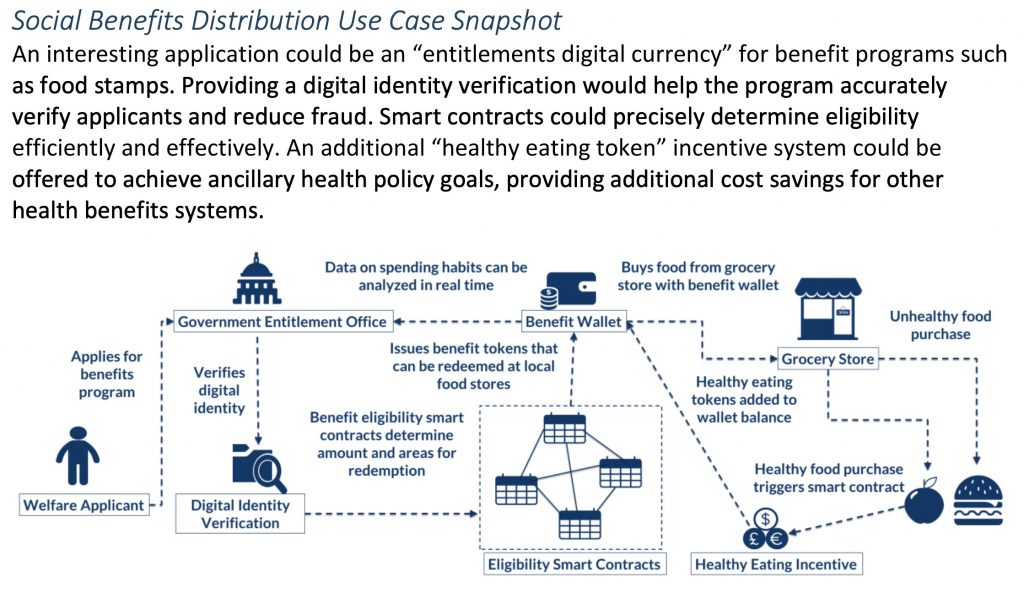
• NASAis in the process of utilizing blockchain and smart contracts for some of its projects, one being their SensorWeb program which creates an interoperable environment of earth observing satellite sensors.
• Chemonics International, a big USAID contractor, has won an award for their development of the blockchain for Biodatas Solution, which they developed with BanQu. This platform changes the entire USAID contracting mechanism, by eliminating the need to collect, verify, and store personnel information, while expediting the process. As a reminder, in 2015 Chemonics was awarded a $9.5 billion eight-year IDIQ contract by USAID to fund health supply chain programs to prevent HIV/AIDS, Malaria, and Tuberculosis, making it the largest USAID awarded to date. Chemonics was only able to get 7% of the shipments delivered on time and in full. To date, it’s a bit of a mystery as to where all the drugs went, as well as the $9.5 billion. Nonetheless, just three years later, the Bill Gates Foundation granted $386,680 to Chemonics to “monitor the temperature of critical health products along the global health supply chain to ensure the quality and efficacy of these life-saving products.” Essentially, the same job they had already epically failed at.
• Visa has applied for 159 blockchain-related patents that involve making transactions more secure and using biometrics to verify someone’s identity. In 2020, they filed a patent to create a blockchain-based digital currency with the goal to replace cash. They wish to act as a central entity computer that creates a digital currency using a serial number and denomination of physical currency. This patent would apply to all digital currencies; Ethereum, CBDCs, pounds, yen, and euros. Last year visa partnered with Ethereum to connect its payment network of 60 million merchants to the U.S. Dollar Coin (USDC) developed by Circle Internet Financial. Entrust, a partner of The Good Health Pass, who was recently contracted by the UK to produce digital Covid certificates, announced its Visa Ready certified partnership and Visa Fintech Partnership, in June 2021. Entrust was covered in part 3 of this report. In July, Binance, the world’s largest cryptocurrency exchange with a $2 trillion trading volume last year, rolled out a Visa debit card that automatically converts users’ crypto assets to local currency.
• In 2018, Oracle launched its blockchain-based Global Shipping Business Network, a maritime shipping consortium that includes container-shipping giants and port operators.
• Louisiana is ahead of the game and has already created the “LA Wallet” which utilizes a QR code so pull up driver’s license information that replaces an actual plastic drivers license. They are now integrating the Covid injection smart health cards.
• Hyperledger is an umbrella project of open source blockchains and other related tools that launched in 2015 by the Linux Foundation. They’ve received funding from IBM, Intel and SAP Ariba. The Fabric (Hyperledger Project) is a Collaboration between the Linux Foundation and over 80 financial and technological companies including IBM, DTCC, JP Morgan, Accenture, and CISCO.
• India has added 300 million bank accounts in just three years, with government-managed online standards in online payments and digital identity. India has also partnered with Accenture and BetterPlace Safety Solutions to create “Safedrive” for female employees, which shares the photo and data of a driver with the employee before picking them up, through blockchain authenticating with the driver’s background data, all done through smartphones of course.
• Ghana will become the first country to use contactless biometrics for their national vaccination program, beginning in October. Ghana Health Service partnered with Bill Gates’ Gavi to track the administering of vaccines, including the Covid-19 injection, using biometrics created with Simprints technology with support from Cisco. They are also working on integrating the biometrics into universal health coverage.
• Nigeria also has a biometrics scheme rolling out, with 60 million digital identities already linked to their SIM cards, and a new deadline of October 31, 2021 to get everyone on board. UGS Technologies, an enrollment partner, sealed a deal to register the biometrics of Nigerians living in the UK and in six other European countries for the National Identification Number (NIN) system as well.
• Boeing’s HorizonX venture arm is helping to fund the development of SkyGrid, a blockchain-enabled air traffic control system that tracks and communicates with drones. It’s been approved by the FAA to provide drone pilots with authorization, creating a permanent record of data. They believe it is important for package delivery, industrial inspections, and the future of autonomous flying taxis.
• Cargill partnered with Archer Daniels Midland (ADM), Bunge, COFCO, Louis Dreyfus Company, and Glencore Agriculture, in the Covantis platform, using Ethereum-based Quorum blockchain to create tracking records on moving grain and oilseed cargoes around the world.
• Walmart is running a pilot program with U.S. Customs and Border Protection to track imported foods via blockchain.
Additional Information
The World Bank Group published a paper on ‘Distributed Ledger Technology (DLT) and Blockchain’ in 2017. It gives a good breakdown of what a DLT is and how it works, how they relate to digital currencies, applications of DLT, smart contracts, and how they intend to leverage it. This was a collaboration between the Linux Foundation and over 80 financial and technological companies including IBM, DTCC, JP Morgan, Accenture, and CISCO.
UK Government’s Office for Science – ‘Distributed Ledger Technology: Beyond Blockchain,’ explores how distributed ledger technology can revolutionize services in government and the private sector.
Wallets, Cryptocurrency, Central Bank Digital Currency (CBDC), and Banks of The Future
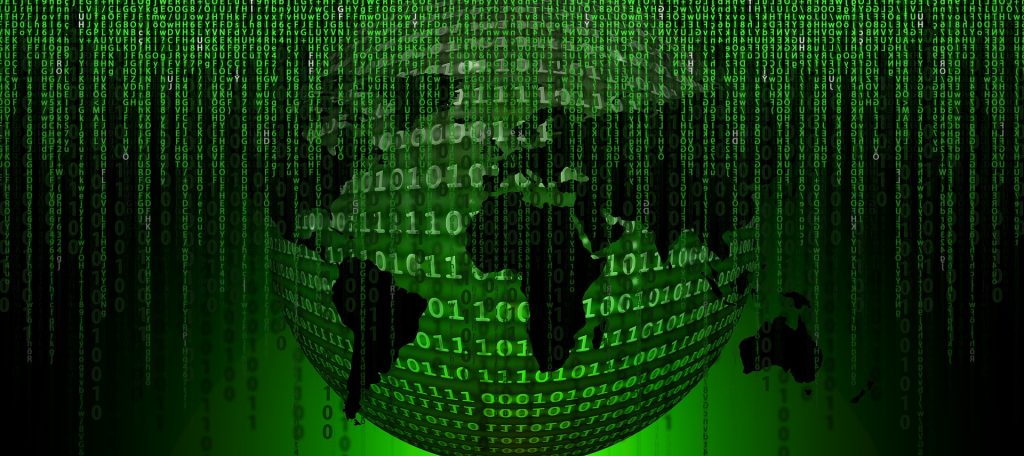
“We’re on the cusp of another breakthrough innovation, including the poorest, in a financial system that increases instead of limiting the value of their assets. Transforming the underlined economics and financial services through digital currency will help those who live in poverty directly.” – Bill Gates
Plain and simple: they are using the pandemic and BlackRock’s “Going Direct” financial takeover to manipulate minds and manufacture industries. Their goal is to get everyone on broadband, carrying a smartphone, plugged into the grid with their QR digital id and onto blockchain platforms. The financial aspect of this is important to understand so that people can fight it every step of the way. John Titus of The Solari Report put together an indisputable parallel timeline between “Going Direct” and Covid, which by itself, reveals the globalists plotting to intentionally crash markets and bring people to their knees while they made off with trillions.
In 2019, the Federal Reserve Bank of Kansas City published an article regarding QR code-based mobile payments in Japan, Singapore, and Hong Kong. Using those for study and comparison, part of their assessment concluded that QR code-based mobile payments substituting for cash will allow banks to reduce costs related to cash services, and will increase the volume of consumer transaction data available to banks and nonbanks, to better understand their customers’ behaviors and needs. They also feel that the QR code is a speedier, safer, and more convenient option than other digital payments. They show concern about the fragmentation with multiple wallets and state that an industry consolidation will help resolve issues with fragmentation.
According to the OECD, digital wallets are among the fastest growing technology markets. Asia already has a billion users through their payment apps, which also integrates their e-commerce, chat, deliveries, food ordering, and ride hailing. Nonbanks are making an impact, such as PayPal, Apple, Google, Revolut, N26, and TransferWise.
The Federal Reserve Bank of Atlanta produced a paper in 2020 titled ‘Shifting the Focus: Digital Payments and the Path to Financial Inclusion‘. Again, with the “financial inclusion” nonsense. In it, their theory on preserving cash is that by “facilitating the continued use of cash may hurt consumers who may not otherwise be motivated to go digital, all else being equal. We may be perpetuating the use of a less efficient payment method, with both businesses and consumers suffering in the end.”HAAAA! Sorry, not to break up a serious report, but this is a boldface lie. Has anyone ever been hurt by cash, or suffered from having it? Think of the sheer manipulation is these twisted words.
They also point out the fact that there is no federal law in the U.S. that mandates cash acceptance, but that several cities and states have passed legislation that bans businesses from refusing to accept cash. Surprisingly, they are Massachusetts, New Jersey, Pennsylvania, San Francisco, Philadelphia, Washington DC, and New York. Perhaps the newly introduced Payment Choice Act of 2021 will make it through legislation and protect consumers across the country from businesses rejecting their cash payments.
Despite their trickery and tactics, cash is actually on the rise. They want everyone to believe that people are using cash less and less and everyone wants a bank account linked to digital currency, but the reality is that people don’t trust the banks and haven’t for a very long time, and the majority of those in developing countries without bank accounts, do not want them. All of this is being pushed through under the guise of “poor people,” everyone wants a “digital world,” and this will all help with “climate change” and “the economy.” It’s all nonsense.
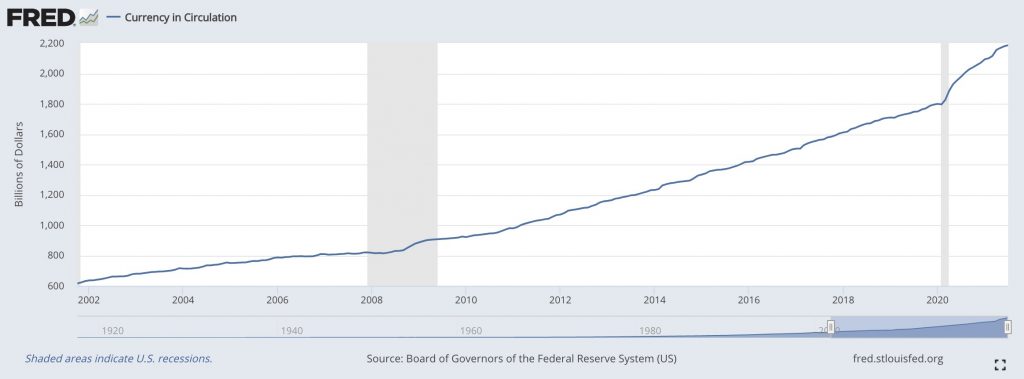
This chart reflects the rise of currency in circulation. This is very important. People need to continue this trend. Using cash as often as possible prevents the tracking of where you are spending your money, which is the REAL reason why they want to go digital, so they can control it. Why give any of them swipe fee earnings, when you can use cash in many cases? If people would remove their money from the bigger banks and support the community banks, it would hinder their plans greatly. Continue to use cash as often as possible.
The banks want your digital identity by any means necessary, which was covered in part 3, so mandating injections to have physical access to your bank is an obvious tactic they will use. Morgan Stanley was the first big bank to ban it’s employees and clients from their NY location, if not vaccinated.
McKinsey & Company used Covid-19 for “Making the case for robust digital financial infrastructure” that is tethered to an ID:
“The effectiveness of the 12 Covid-19 programs we analyzed depended greatly on the presence of the three structural features of financial infrastructure: digital payment channels, the presence of a basic digital identification system with broad population coverage, and simple data on individuals and businesses that are tethered to the ID.”
As seen in the section above on Blockchain, that is where they are headed with all of this. Gartner Inc. forecasts new uses of blockchain could generate $3 trillion in value by the end of the decade.
The Depository Trust & Clearing Corporation (DTCC), who does $2.2 quadrillion in securities, has been changing up their services. In 2017, they announced plans to utilize blockchain technology for credit default swaps, in collaboration with IBM, Axoni and R3CEV. Axoni is backed by Goldman Sachs, JPMorgan, Wells Fargo, and ICAP, as well as others. Once implemented, the blockchain-based credit default swaps platform will process up to $11 trillion on a yearly basis.
In 2020, the European Commission contracted with BlackRock to carry out a study on integrating environmental, social and governance (ESG) objectives into EU banking rules. As discussed in Corey’s Digs report on the financial takeover, this is already being done in the U.S. as well. They are using climate change as a way to monitor how you are spending your money and will soon be assigning you a credit score based on ESG as well as a social credit score… if we allow this to continue.
Remember, there are 12 regional Federal Reserve banks, with the New York Fed being the most important. It is the only regional branch with its own trading floor, it houses the Exchange Stabilization Fund, and is the only permanent member of the Federal Open Market Committee which buys and sells U.S. government securities. The majority of the programs carried out under the guise of the pandemic response, were run by the New York Fed.
Money is Flowing in
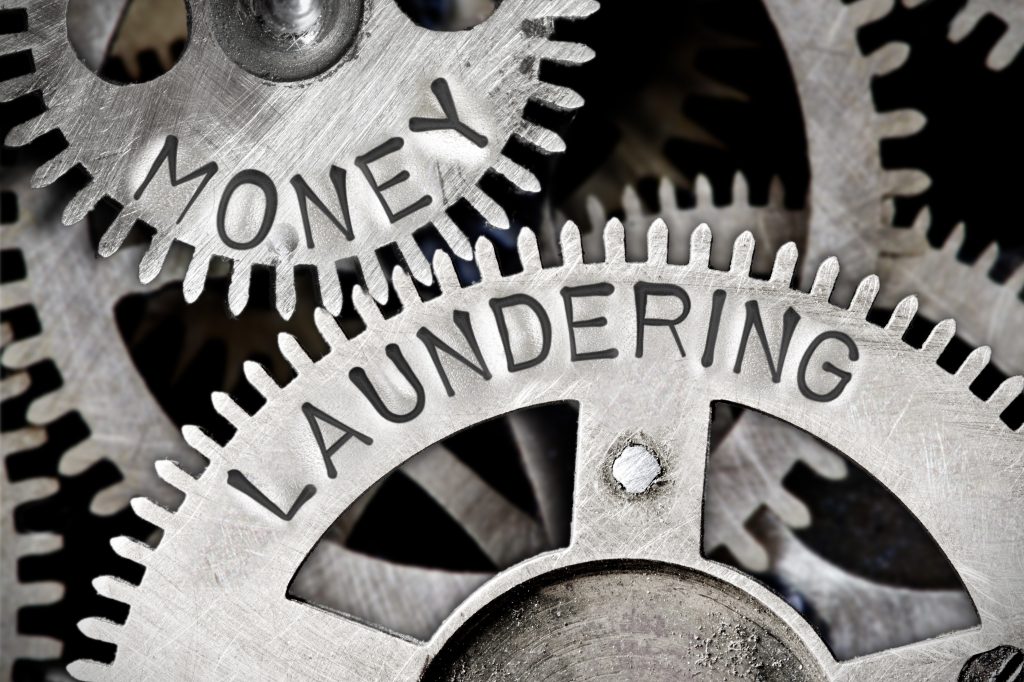
Before getting into crypto and digital, it’s critical to understand that those allegedly funding the “pandemic” are really utilizing those funds to build the human enslavement system and smart grid infrastructure with heavy surveillance over humanity. This is just one area where major slush funds have been taking place for years, building up to this moment in time where they go “all in.” The same folks have been contributing to the HIV/AIDS Global Fund slush fund for years as well, which is also a Bill Gates organization. The same individuals and companies that are profiting from the pandemic are also heavily involved in the technology and digital currency future. Money is flowing in through COVAX, founded in April 2020 by the World Health Organization, European Commission, and government of France, which is a worldwide initiative to get Covid-19 injections out to the world via Bill Gates’ Gavi. COVAX is also co-led by the Coalition for Epidemic Preparedness Innovations (CEPI), which of course is also Gavi, the WHO, and UNICEF.
Just last week, CEPI joined the Wellcome Leap Fund created by the Wellcome Trust last year, in a $60 million program to support a network of RNA-based biofoundaries for access to diverse biologics, including mRNA vaccines and monoclonal antibodies. Wellcome Leap is lead by former director of the Pentagon’s DARPA, Regina Dugan, and the chairman of the board, Jay Flatley, is the former long-time head of Illumina, the largest maker of DNA sequencers. Wellcome Leap’s goals seem to align with the merging of AI and humans, with extensive surveillance measures. Journalist Whitney Webb did an extensive report on this.
China has been funding Gavi since 2015, and on June 4, 2020 they made a pledge of another $20 million to run through 2025. Greece has pledged $1.8 million to COVAX. The Netherlands, one of the original six donors to Gavi, has pledged over $365 million to Gavi. Norway, also one of the original six donors, has contributed a whopping $1.14 billion to Gavi. The U.S., Gavi’s top donor and one of the original six, has given well over $2.5 billion to Gavi. Those are just a few countries tied in with Gavi. Scroll down on any of the Gavi links above to lookup other countries and donors.
Numerous companies have contributed funds to Gavi and COVAX, such as Shell, who is a member of the World Economic Forum (WEF), has pledged $10 million, TikTok whose parent company is ByteDance and is also a member of the WEF has pledged $10 million, UPS (also WEF) $1.3 million, Unilever (also WEF) has pledged $2.3 million, Mastercard $5.3 million (also WEF), to name a few.
Another big funder of COVAX is Wise, who has contributed $5 million thus far. Wise (formerly TransferWise) is a London-based global online money transfer service that supports more than 750 currency routes across the world, and is making an impact on an international level. Wise was founded in 2011, with funding from Richard Branson, Peter Thiel, PayPal co-founder Max Levchin, and others. They have partnered with banks and companies such as Bolt, GoCardless, and Monzo who just recently applied for a U.S. banking license.
It is the same network of people over and over again, plotting out the next manufactured crisis, swooping in to collect money to save the day, and building new industries that enslave humanity.
Where is Cryptocurrency Heading?

Once again, the Infrastructure Investment and Jobs Act that recently passed in the Senate, is really about building out their “smart grid,” which means getting everyone plugged in, QR-coded, on the blockchain, for total surveillance and governance. Part of that governance includes regulating cryptocurrency with the hopes of generating $28 billion in tax revenues. It also includes very broad language for “brokers” to be responsible for reporting, so everyone in the crypto industry is waiting patiently for a more detailed description. The implementation is not set to take place until the end of 2023, and the House is still working on modifications. So it’s a wait and see situation at the moment.
Either way, it seems crypto is headed toward some level of regulations and reporting mechanism to be sure they get a tax cut. Ultimately, once they’ve established a digital currency, which is fully trackable, they may try to do away with crypto all together.
In Beijing, China, the world’s largest bank is now running 30 blockchain applications so customers can trace their healthcare coverage and see how their philanthropic donations are being spent. In May, China banned financial institutions and payment companies from providing any service related to cryptocurrency transactions, while at the same time, piloting their own digital Yuan currency. In spring 2021, the International Finance Forum (IFF) held its annual conference in Beijing, to discuss the post pandemic era and a sustainable future, which included a presentation on blockchain by RChain. Former World Bank president Jim Yong Kim, IMF President Kristalina Georgievain, and UN Secretary-General were all in attendance as well.
In the U.S., it seems that many financial institutions are getting on board with crypto, for the time being, as it may be awhile before they move to a CBDC. For example, at New York’s Signature bank, they are serving institutional crypto customers so they can deposit money in their crypto trading account through its Ethereum-based Signet platform. In 2020, crypto deposits increased from $2 billion to $10 billion. In 2019, Harvard University invested in the crypto market, joining two other investors in an $11.5 million backing of Blockstack Inc, a cryptocurrency company. Harvard even offers a course on the introduction to blockchain and Bitcoin. According to the Harvard Crimson, Harvard Management Company, the firm who manages the University’s $41.9 billion endowment, has been investing in Bitcoin since 2019.
A Crypto Climate Accord?

On April 8, 2021 the Crypto Climate Accord was launched by Energy Web, Rocky Mountain Institute (RMI) and the Alliance for Innovative Regulation (AIR). Inspired by the Paris Climate Agreement, this alliance, consisting of over 150 partners, is seeking to make the cryptocurrency industry 100% renewable by 2025 or sooner. They want to enable all of the world’s blockchains to be powered by 100% renewables, develop an open-source accounting standard for measuring emissions, and achieve net zero emissions for the entire crypto industry – including all business operations beyond blockchains, by 2040. Some of their partners include Argo Blockchain, Bitcoin Latinum, Blockchain Founders Fund, CoinShares, Consensys, DMG Blockchain Solutions, Gryphon Digital Mining, NortonLifeLock, RChain, Ripple, Skyline Renewables, Tom Steyer, Vancrypto, plus over 100 others. Of course, they are also supported by the United Nations Framework Convention on Climate Change.
For those who may not know, the Rocky Mountain Institute (RMI) was founded in 1982 by Hunter Lovins, and in December 2014 merged with Richard Branson’s Carbon War Room to become a subsidiary under RMI. Both companies played a major role in the Ten Islands Pilot program to bring renewable energy to ten islands which eventually evolved to over 23 islands and expanded to the tourism industry, that Corey’s Digs reported on extensively. It involves a lengthy list of players that are coincidentally many of the same players in this series, including 26 governments, the Clinton Foundation, George Soros, Reid Hoffman of LinkedIn, Bill Gates, Jeff Bezos, Mark Zuckerberg, Jack Ma of Alibaba, Marc Benioff of Salesforce, and countless organizations and NGOs. The former disaster risk management specialist for the World Bank and UNDP development specialist, Justin Locke, became the director for the “Islands Energy Program” for the Rocky Mountain Institute in 2014. Former President Barack Obama and the Department of Energy played a big role in this rollout as well.
Energy Web was co-founded by the Rocky Mountain Institute and Grid Singularity, in 2017, along with 10 founding affiliates. The Alliance for Innovative Regulation launched in 2019 by co-founders Jo Ann Barefoot and David Ehrich, both with extensive backgrounds, with the board consisting of a former senior White House advisor and former comptroller of the currency.
Bitcoin is concerned about this new Crypto Climate Accord, questioning their true motives. Noting that the enormous level of energy consumption required to run high-performance computers and meet the demands of this rapidly evolving industry will certainly leave a large energy footprint, they question whether the billionaires and industry evangelists are suddenly regaining a conscience to restore the planet’s ecosystem, or if this is simply a gimmick designed to suppress criticism and provide good PR? They point out that nearly all of the signatories are already using less energy-intensive proof-of-stake (PosS) consensus protocol, so over time, crypto’s energy footprint will automatically decline, which shows these companies are merely promoting themselves as “green” to attract more users, rather than actually addressing any environmental concerns. Being as this is a self-governing body with no oversight, it seems self-serving may be the true motive.
Devolving Into Central Bank Digital Currencies (CBDCs)

This is where it gets tricky, and turning to the brilliant reporting of John Titus of The Solari Report for insight is always helpful. There is quite a dance taking place, not to mention the heated competition among financial institutions and big tech, and understanding the logistics of how this could all roll out on the back end gets a little complicated. The biggest issue is in how they are going to distribute the CBDCs. Will it come from the Federal Reserve or the Treasury? Will it go directly to commercial banks and how will it get funneled out to retail and people? What or who will be the collateral against it? One thing we know for certain, it will function across a blockchain (distributed ledger) platform that will be fully traceable, which is quite different than how cryptocurrency works. The central banks aren’t going anywhere, at least not any time soon, but big tech is already making their moves into the banking industry.
In December 2020, the Bank for International Settlements’ Innovation Hub (BISIH) Swiss Centre, Swiss National Bank (SNB), and SIX carried out a successful proof-of-concept CBDC experiment that integrates tokenized digital assets and central bank money. They stated that they issued a wholesale CBDC onto a distributed digital asset platform; and linking the digital asset platform to the existing wholesale payment system, and it demonstrated feasibility and legal robustness of both alternatives in a near-live setup.
The European Central Bank’s Governing Council just launched a 24-month investigation into digital Euro, focussing on key issues regarding design and distribution of a digital Euro.
U.S. Secretary of the Treasury Janet Yellen convened the ‘President’s Working Group on Financial Markets (PWG)’ to discuss the potential benefits of Stablecoins in July. Yet, that same week, Federal Reserve Chair Jerome Powell stated that “you wouldn’t need stablecoins, you wouldn’t need cryptocurrencies if you had a digital U.S. currency.“
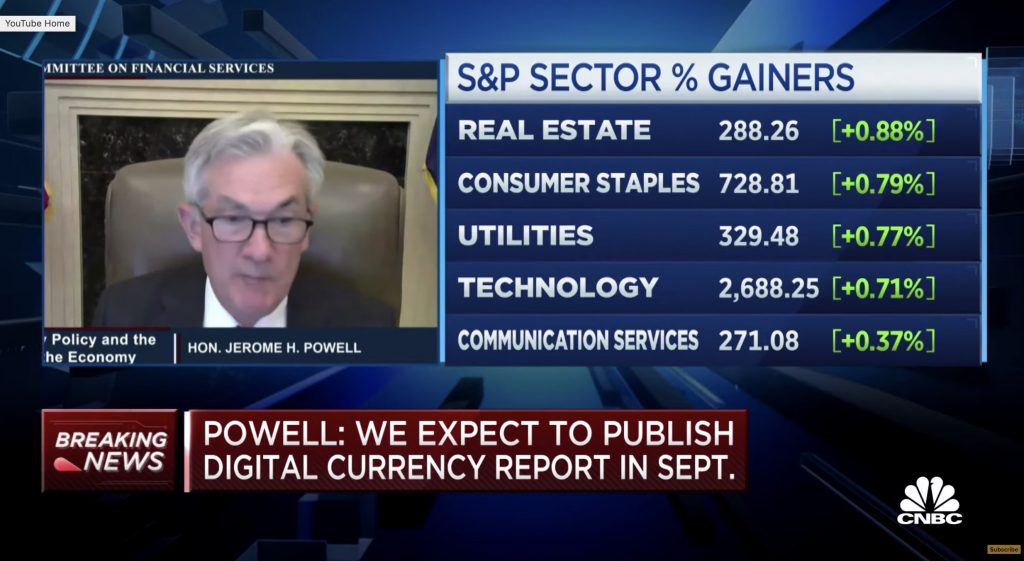
Who Will The Bankers Become in A Digital World?
“We’re understanding the concerns they may have, how CBDCs could be issued. Each government is going to go at a different speed, but there isn’t one government that isn’t envisioning a future with digital fiat currency.” – Dan Schulman, CEO of Paypal
There are currently 4,357 commercial banks in the U.S., down 2,789 since the 2008 financial crisis. In the last 15 years, the Fed approved 3,576 bank mergers, with no denials. In 2016 the Comptroller of the Currency announced they would begin issuing new Fintech Banking Licenses to allow financial technology companies to expand across the country more quickly.
In 2020, the Organization for Economic Co-operation and Development (OECD) published ‘Digital Disruption in Banking and its Impact on Competition.’ The United States is one of 20 founding members and is the largest financial contributor. The report analyzes possible strategies of the FinTech and BigTech players and the role of regulation. They discern that regulation will decisively influence how involved BigTech will become within the industry and who the dominant players will be. They explain that the supply and demand drivers of the digital disruption is driven by the technological developments on the supply side, and by the consumer expectation of service on the demand side. Application programming interfaces (APIs), cloud computing, smartphones, digital currencies, and blockchain technology make up the supply.
According to the report, the United Kingdom, United States, Singapore, Germany, Australia, Hong Kong, and China are the leading FinTech hubs, with China leading the way through BigTech giants such as Alibaba, Baidu, and Tencent. They state that BigTech platforms are much more disruptive to the traditional banking business due to their broad customer base, reputation, less regulatory limits, and an extensive amount of customer data – companies such as Google, Amazon, or Facebook for example. (Though, one might argue that their reputations have been declining.) They believe that due to all of their advantages with a large installed customer base, they can compete head-to-head with incumbent banks by becoming either intermediaries and adding traditional banking products, or be marketplaces that focus on the most profitable banking activities. They also suggest that BigTech firms could monopolize digital payments by denying interoperability with other e-money providers, which means they would control the interface of the customers and banks would have to compete to supply products and services through their platforms.
BigTech companies definitely have a stronghold in the digital world, and can act as gatekeepers to the distribution of financial products. Most banks won’t be able to compete with their bundled product strategies, so they may opt to transform their business into an open platform with other banks and financial intermediaries, or partner with BigTech firms. Controlling the interface with customers is critical. Already, Amazon and JPMorgan Chase have formed a partnership, Apple and Goldman Sachs partnered to offer credit cards, Amazon and Bank of America partnered in loan provision, and Google has been partnering with multiple financial institutions. All in all, the OECD report points out that if BigTech firms enter the banking sector in full force (they’ve already begun), banks will have limited options for staying in business unless they provide specialized unique financial products that BigTech firms cannot offer, or they can become platforms competing with BigTech since they are able to navigate regulations better.
They conclude that FinTech firms will divide into specialized firms with no banking license, and digital banks. The specialized service firms will partner with incumbents and the digital banks will consolidate or sell to the incumbents. BigTech will continue its new venture into the banking services. As regulations evolve, which will include who controls the data, that will determine just how far BigTech can go on its own. Some might say it’s the obvious marriage – BigTech and Big Banks.
Big Tech Making Its Moves into Banking

Using Paypal and Google as two case studies, we can see the direction they are heading and the impact they are having.
Paypal is gunning for a leading position in the future of digital assets and currencies. “This whole idea of establishing a cryptocurrency and blockchain unit within PayPal is how we can be a shaper of that [trend], a leader of that, and not a reactor,” said Schulman. In April, Paypal acquired Curv Inc., a crypto security firm based in Tel Aviv, in February they opened a Visa-branded Venmo credit card, and last year Paypal launched QR codes for in-store transactions, which racked up $6.4 billion in one quarter alone. They piloted their QR code in 28 countries during the so-called pandemic via Paypal Wallet to allegedly help small and medium-size businesses, but didn’t include the U.S. in this pilot program, and only launched it here afterward.
Not only that, Paypal owns Venmo, who processed nearly $160 billion in transactions in 2020. They also provide a Paypal Cash Mastercard, prepaid Mastercard, cashback Mastercard, extras Mastercard, Paypal credit which is a reusable credit line that allows you to pay off a purchase within six months with no interest fee or annual fee, and Pay in 4 which allows you to pay make a purchase with four installments two weeks apart, which is also interest free. They’ve even partnered with Bancorp Bank and others in order to provide FDIC insurance on there credit cards they offer. If you have a Paypal cash card, they will deposit your funds into a pooled account that is held by Paypal at an FDIC-insured bank. They have also partnered with WebBank, a Steel Partners Company, to offer business loans. So essentially, Paypal is already operating as a partial banking system, but doesn’t provide checks, auto loans, mortgages or wealth management. That seems like an easy area for big banks to slide into, using Paypal as the middle man interface. They even have a system in place to pay your taxes directly to the IRS.
That said, would Paypal and other big tech firms become a controlled gatekeeper for the larger banks and choose not to partner with smaller banks in the future, forcing mergers, acquisitions, and a monopoly? In January, JPMorgan Chase & Co. CEO Jamie Dimon went on a rant about “unfair competition” because of the audacity of tech companies and smaller banks to compete with them. Apparently, regulation requires that banks put two unaffiliated networks on every debit card they issue and retailers then have the ability to choose which network handles a transaction. However, banks with assets under $10 billion are exempt from this regulation. This allows tech players to partner with small community lenders and obtain bigger fees, which of course the big banks don’t approve of. So in January, JPMorgan Chase & Co. made this threat:
“There are examples of unfair competition which we will do something about eventually, people who make a lot more on debit because they operate under certain things, the only reason they can compete is because of that,” JPMorgan Chase & Co. Chief Executive Officer Jamie Dimon warned in January. “You can expect that there will be other battles that take place here.”
Then, seven months later the SEC opened an investigation into Paypal over whether the swipe fees paid to the banks that issue Paypal’s debit cards meet Federal Reserve guidelines. The Federal Reserve is now weighing changes to its rules governing debit cards, after the central bank asked for public comment on an amendment in May.
JPMorgan Chase has signed up over 400 banks, including Deutsche Bank and Mexico’s Banorte, for internet banking transactions, using their Liink blockchain network. The goal is less paper checks and more online transactions.
Google has been busy building partnerships with banks to provide actual checking accounts through their new Google Plex which is integrated with Google Pay. Thus far, they already partnered with 11 financial institutions, including Citi, BMO Harris, and Stanford Federal Credit Union. Google Pay already operates with 5,000 financial institutions, so they are pitching partnerships to banks and credit unions:
“You’re lagging in technology. Your current vendors are years behind. Consumers think you’re irrelevant. We’re hip, we’re cool, we have all the latest technologies, and boy have we’ve got data! Come partner with us on our new checking account!”
Google pay has quite a bundle, from Plex to Verge, to Explore which uses a QR code, shopping, insights to track your spending, and more. Google also provides cloud computing services to financial institutions.
In fact, Equifax utilizes Google’s cloud. Credit scoring company Fair Isaac announced Jan 23, 2020 (right after Covid hit) that they were changing the scoring system, making it harder for people to get loans. Equifax made the change first in summer 2020. But, Freddie Mac and Fannie Mae still have to go by the old scoring system. In 2018, Equifax spent $1.2 billion to move all their data to Google Cloud. Of course, they allege they implemented this due to a data security breach. Equifax is a partner with WEF, and the WEF and others have already explained how the future of credit scoring will be different, to include a social and climate score.
Banking Licenses
Many of the big techs seem to be staying away from the banking licenses and partnering up with banks instead, likely to avoid dealing with regulation headaches. Banking licenses are very costly and come with strict regulations, but can also provide FDIC insurance. To obtain a license a financial company has to meet a strict set of regulations, keep financial reserves on hand, and ensure data systems are secure. However, some tech companies are taking it all the way. There are four types of banking licenses:
A) Traditional license: what most banks have
B) Extended license: allows a fintech company to partner with a parent bank to operate under their license
C) Fintech (virtual) license: available to digital-only banks operating solely online. This newer banking license was announced by the OCC in December 2016, to allow financial technology companies to expand across the country.
D) E-money license: allows companies to offer payments and financial services such as transfers and currency exchange, but not manage deposits and operate like a bank
Some tech companies have recently filed or secured a banking license:
Adyen, a Dutch payment company based in the Netherlands, was recently approved to establish a U.S. federal branch license in San Francisco, CA.
Monzo Bank Ltd, an online bank based in the UK, has filed for a banking charter in the U.S.
Revolut, a financial technology company based in London England, has filed for a bank license in the U.S. The company launched in 2015, is currently valued at $33B, and just last month raised $800M in a funding round. SoftBank’s Vision Fund 2 and Tiger Global Management led the deal. Alibaba founder Jack Ma previously served on the board of SoftBank.
SoFi (Social Finance Inc), an online personal finance company, received a conditional approval for a national bank charter allowing for it to receive deposits and make loans on its own.
Square was approved for a banking license last year to form a Utah-based bank.
Varo Bank, a subsidiary of fintech Varo Money, Inc, received approval of a national bank charter.
What About Government-Run Banks?

Is it possible that we will begin to see public banks popping up, run by government? As of right now, the only public bank in the U.S. is The Bank of North Dakota, but they are a state-owned wholesale bank that actually helps the little guys. Essentially, public banks could wipe out community banks, so it’s not something we want to see happen.
Why is this a plausible option? In 2020, Sen. Bernie Sanders called for a government-run banking system that would be set up through the Federal Reserve and U.S. Postal Office. This was proposed through the Biden-Sanders “Unity Task Force” which called for a new public banking infrastructure. This was another “idea” based on helping low and middle-income families establish bank accounts with real-time payment systems. Though, Federal Reserve Chair Jerome Powell didn’t seem to be on board with this concept, the Washington Post touted it as something that needs to become a reality. Of course they all sell it as an advantage, as though a “public bank” means it’s all about the people and how much more secure everyone will be vs with a private bank, leaving people to forget the fact that they would be government-run.
The World Economic Forum is on board with public banking as well. In fact, they published an article in October 2019, regarding California’s recently enacted public-banking law. In it, they stated:
“The banks must be governed well to stay on mission, and the governance regime itself must be monitored to ensure that it remains both effective and complementary to that mission. At the end of the day, mission drift may be unavoidable. But detecting it and instituting the necessary governance reforms is well within governments’ power. It would be a tragic mistake to assume that passing a public-banking law amounts to mission accomplished. The mission has only just begun.”
They’re not the only ones trying to sell this new banking model. The House Financial Services Subcommittee discussed it in July 2021, during their hearing titled ‘Banking the Unbanked: Exploring Private and Public Efforts to Expand Access to the Financial Systems‘. They assessed proposed legislation, and all put in their two cents, with several in favor of public banking. The eye-catching statement by Steven Lofchie was telling. He suggested that since the Post Office is reportedly losing $36 million a day and has massive pension obligations, a strong argument can be made that the Post Office does not have a profit-making motive. Ah yes, the great “crash” of the Post Office is coming full circle now.
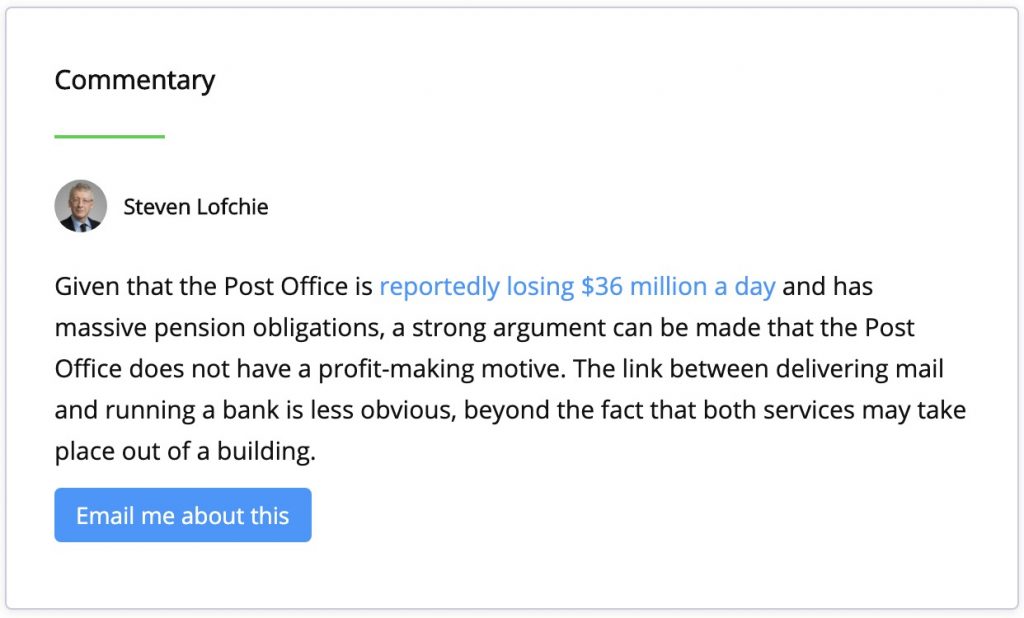
Could it become a reality? Let’s take a look:
In 2019, Gov. Newsom signed into law that California cities and counties will be allowed to establish public banks, making them the second U.S. state to allow it – North Dakota being the first. That seemed to have kicked things off, because in 2020 four Federal bills were introduced for public banking and postal banking. Postal banking has been around forever, so it wouldn’t be a stretch to expand on it, especially if they took it online as well. Some of those bills may be reintroduced or snuck into other bills since they didn’t make it through in 2020.
As of this year, there has already been legislation introduced from eight different states: California, Hawaii, Massachusetts, New Mexico, New York, Oregon, Pennsylvania, and Washington. The Public Banking Institute has put together a map indicating what’s happening on the public banking front across the country, with all legislation linked below the map.
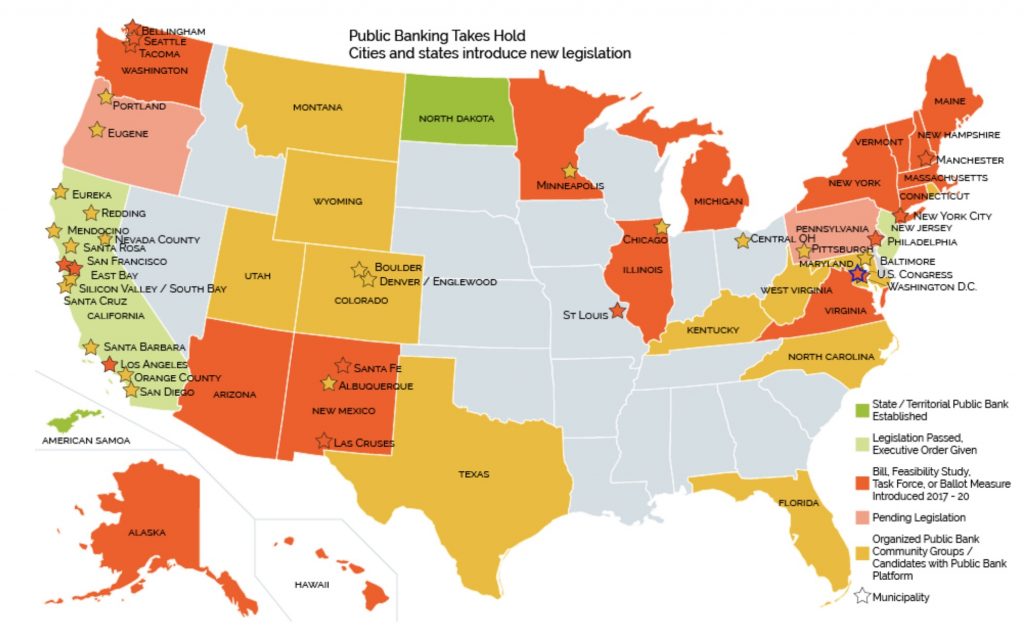
Here’s an example of one of three separate bills introduced this year in New York alone:
New York: Senate Bill S1762A “New York Public Banking Act” introduced on January 14, 2021. It would authorize municipal and other local government to form and control public banks through the ownership of capital stock or other ownership interest, and to loan or grant public funds or lend public credit to such public banks for the public purposes of achieving cost savings, strengthening local economies, supporting community economic development, and addressing infrastructure and housing needs for localities.
One can see how they could create government-run public banks and utilize the USPS website platform to expand it to include banking and financial products, allowing them to attempt to compete with Big Tech. All state and community websites could easily promote this to direct people to the USPS site as well. So this is something to keep our eyes on.
Current Financial Legislation Introduced To Keep An Eye On
Financial Inclusion in Banking Act – H.R.1711
Passed in the House on May 18th. This bill expands the duties of the Office of Community Affairs within the Consumer Financial Protection Bureau regarding under-banked, un-banked, and underserved consumers. Specifically, the office must (1) report on impeding factors for individuals and families that do not participate in the banking system, and (2) develop strategies to increase such participation.
Translation: Get everyone in the banking system to be able to control their money via a social and climate scoring system.
Corporate Governance Improvement and Investor Protection Act – H.R.1187
Passed in the House on June 16, 2021 with a 215-214 vote. It is sitting in the Senate. This bill requires an issuer of securities to annually disclose to shareholders certain environmental, social, and governance metrics and their connection to the long-term business strategy of the issuer. The bill also establishes the Sustainable Finance Advisory Committee that must, among other duties, recommend to the Securities and Exchange Commission policies to facilitate the flow of capital towards environmentally sustainable investments.
Translation: Monitor ESGs for climate scoring system via banks and investments to allow or disallow access to an establishment or spending capabilities.
Payment Choice Act of 2021 – H.R.4395
This is a positive bill that was introduced in July 2021 to protect American currency as a form of payment for goods and services. It would make it illegal for retail businesses to reject cash for in-person, consumer transactions at stores across the country. The bipartisan bill has 28 co-sponsors.
Additional Information
International Monetary Fund
Virtual Currencies and Beyond: Initial Considerations
Bank for International Settlements (BIS)
CPMI Paper: Digital Currencies
Augmented Humans & Artificial Intelligence

“This is a whole new era where we’re moving beyond little edits on single genes to being able to write whatever we want throughout the genome.” – George Church
There is a lot to unpack in this section, as this is their ultimate goal – the “augmented human” who interacts with robots and trains artificial intelligence – all plugged in together, while the globalists solve their immortal life goal. In the interest of keeping this section from becoming too lengthy, much of it will be bullet points with referenced source material.
According to the UN, artificial intelligence is forecasted to generated nearly $4 trillion in added value for global markets by 2022.
• That National Security Commission on Artificial Intelligence (NSCAI), chaired by former Google CEO Eric Schmidt, was founded in 2018, as an independent commission of the U.S. for the purpose of making recommendations to the President and Congress to “advance the development of artificial intelligence, machine learning, and associated technologies to comprehensively address the national security and defense needs of the United States.” There are fifteen commissioners which includes individuals from Oracle, Microsoft, Google, In-Q-Tel, and Amazon.
• In July 2021, NSCAI held a Global Emerging Technology Summit on Artificial Intelligence where NATO’s Deputy Secretary General Mircea Geoană was one of the panelists. The Secretary General of the Organization for Economic Co-operation and Development (OECD), an intergovernmental organization consisting of 38 member countries, was also on the panel. The OECD works through over 300 committees, working groups, and experts in areas of policy making.
Discussions involved investments and partnerships in biotechnologies, big data, autonomy, military, NATO’s landmark strategy of AI, EU proposal for a transatlantic agenda for global cooperation, China’s edge on AI, OECD’s recommendations on neurotechnology, G7, and of course climate change. “I mean, pretty much we’re starting to think that machines can think like us. We’ve got unbelievable achievements in biotech, in robotics, of course, 5G as a platform to make it all happen,” said Oracle CEO Safra Catz. They state that NATO has the power of standardization which automatically becomes the gold standard.

• In June 2021, the OECD released their 93-pg report on the “State of Implementation of The OECD AI Principles” which has been adopted by over 46 countries and the G20 AI Principles as well. They are also focused on a regulatory and policy treatment of blockchain technology which they plan to have a public consultation on later this year. They have also set the standards for broadband and telecommunications infrastructure, “including the development of transparency reporting frameworks for terrorists and violent extremist content online,” in the 5G network rollout. Read that again.
Part of their strategy involves countries developing centralized, accessible repositories of open public datasets including government health records and satellite data. They promote initiatives that enable private sector data sharing. Pages 88-91 of this report list the AI network of experts working group on national AI policies with a breakdown of organizations and corresponding countries.
This entire report breaks down what is happening with AI, robotics, labor force, data collection, biometrics and digital control mechanisms across the world, going into detail in specific countries. It is far too much to cover in this report, but is a definite recommended read to understand the full landscape of their intentions.
• The National AI Initiative Act of 2020, which was implemented January 1, 2021, budget authorizes nearly $4.79 billion in funding for AI research at the National Science Foundation over the next five years, $1.15 billion at the DoE, and $390 million at NIST. The US National Security Commission on Artificial Intelligence (NSCAI), launched in March 2021, is calling for at least $8 billion towards AI R&D annually.
“The NSCAI final report presents an integrated national strategy to reorganize the government, reorient the nation, and rally our closest allies and partners to defend and compete in the coming era of AI-accelerated competition and conflict.”
The report also states that they want the government to stand up a task force and 24/7 operations center to confront digital disinformation and that biosecurity must become a top-tier priority. They go on to say that the U.S. should lead an Emerging Technology Coalition and establish a multilateral AI research institute for a global research hub, and that “the Department of State should be reoriented, reorganized, and resourced to lead diplomacy in emerging technologies.”
• The National Science Foundation (NSF) has an annual budget of $8.5 billion and funds 27% of the total federal budget for basic research conducted at U.S. universities and colleges. The Bill & Melinda Gates Foundation funded NSF $24 million in 2008 for agricultural development. NSF has created numerous AI Research Institutes across the U.S. Below is a screenshot of the interactive map on their website.
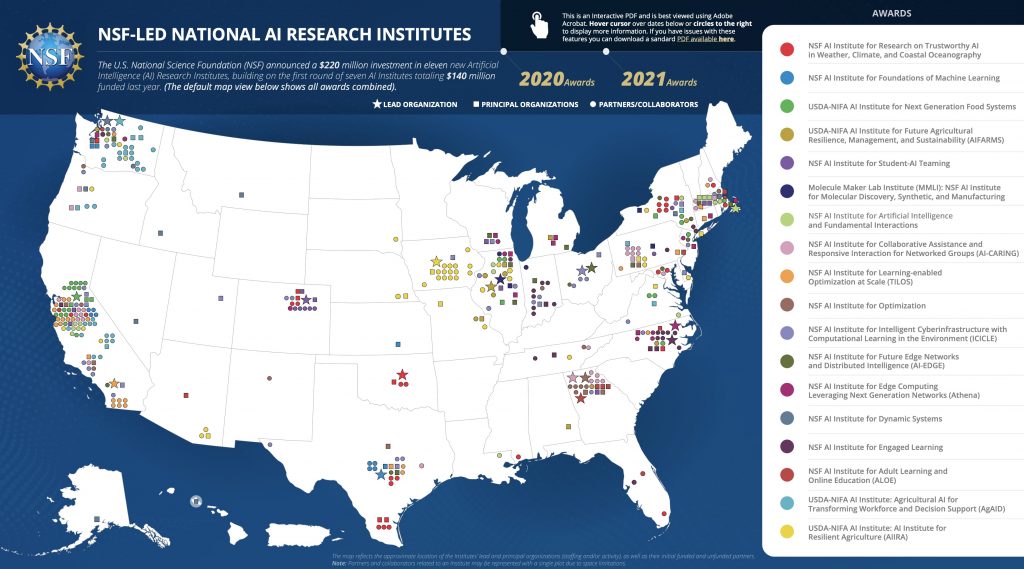
“We are faced with a gift from God, that is, a resource that can bear fruit of good.” – Pope Francis on artificial intelligence
• The $500 million U.S. government-funded Frontier supercomputer is set to launch in 2022, under the direction of the Department of Energy, at Oak Ridge National Laboratory managed by UT-Battelle LLC. It is one of the world’s most powerful and “smartest” scientific supercomputers with high performance computing and artificial intelligence, and is the nation’s first exascale system that can exceed a quintillion calculations per second, built by Hewlett Packard.
• The World Economic Forum is concerned that masks are interfering with facial recognition software, so they feel they should use technology developed by the Pentagon and NASA that can ID you from your heartbeat using a laser, referred to as CardioID. Their marketing spin? “Security in a heartbeat.” Forbes likes to call it “surrender to the rhythm,” but they’re not wrong about the fact that it’s straight out of the movie ‘Minority Report.’
• In 2019 Elon Musk gave a presentation about Neuralink brain-machine interfaces, a technology that he views as allowing a “merging with AI.” At that time, his goal was to have it in a human patient by 2020, but thus far has tested it on pigs and a monkey. Harvard professor Charles Lieber, an expert in nanotechnology and brain science, was one of the top scientists in communicating with Musk and Neuralink. Lieber is currently facing trial on federal charges for lying about his connection to Chinese universities, participating in their Thousand Talents Program, and not reporting income he received from Chinese government entities. Google and Dubai-based firm Vy Capital have contributed funding to get it off the ground.
• Elon Musk has also launched his Starlink satellite network this year, which are low-orbiting satellites said to provide high-speed internet access to people in remote areas. It consists of the worlds largest satellite constellation with more than 1,500 operating in a dozen countries.
• A month into the so-called pandemic, the Roman Catholic Church joined IBM and Microsoft to agree on a “universal ethical paradigm on artificial intelligence.” The UN Food and Agricultural Organization, Italy’s technology minister, and others also partook in this co-signatory venture. Pope Francis addressed some of his concerns but is in support of AI and robotics, and believes “we are faced with a gift from God, that is, a resource that can bear fruit of good.”
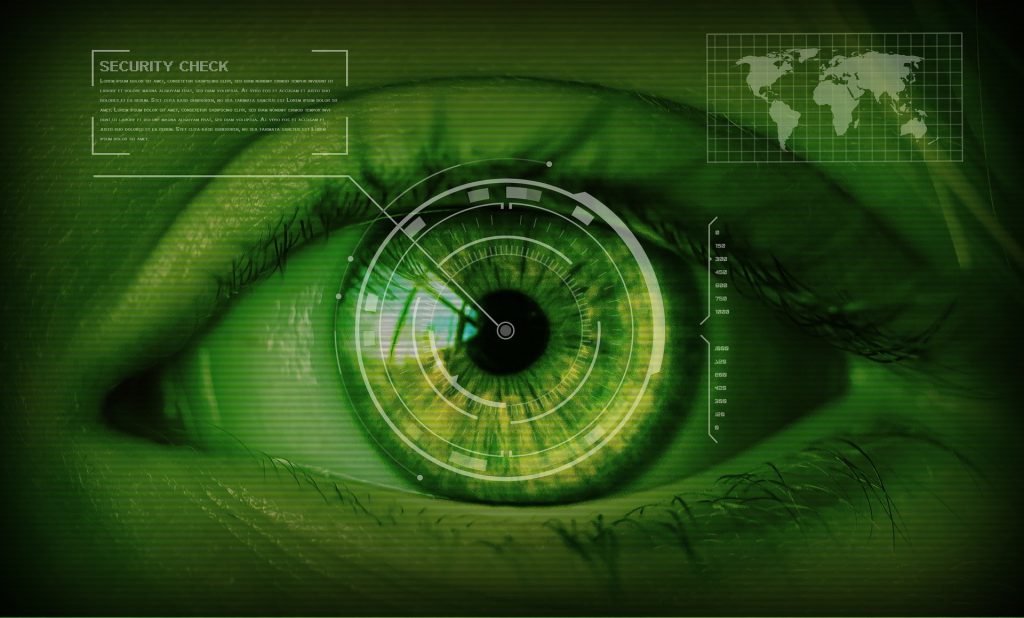
• In November 2020, NATO launched their own in house biometrics system for data sharing between nations.
• In May 2021, the U.S. Military integrated their biometrics-enabled watchlist with the DoD’s ABIS. They are working on multi-modal fusion matching and improving biometric face-matching capability through AI and machine learning, and have already improved their long-range infrared cameras. Looking toward the near future, they are also focused on palm print biometrics, faces in crowds, integration to identify threats online, and non-traditional latent DNA collection.
• A 2013, 31-page white paper titled ‘Dreaming The Future of Health for The Next 100 Years,’ funded by the Rockefeller Foundation, reads much like a dystopian eugenicists dream. They talk about opening a window to the future and what that looks like after 2030 and beyond 2050. In many cases, they speak of it in scenarios as though it is happening right now. They phrase things as “winners and losers,” “inclusive and exclusive,” and the all time favorite – “augmented and non-augmented humans.” They describe a scramble for resources and show a fictitious chatroom where someone by the name of Raul is telling the others that “there is a hot virtual debate in the political forum today on the growing social difference between augmented and non-augmented people.”
This paragraph that falls under a section deemed what they are more certain about with our future, gives a brief look into this white paper as a whole.
“We will interact more with artificial intelligence. The use of robotics, bio-engineering to augment human functioning is already well underway and will advance. Re-engineering of humans into potentially separate and unequal forms through genetic engineering or mixed human-robots raises debates on ethics and equality. A new demography is projected to emerge after 2030 of technologies (robotics, genetic engineering, nanotechnology) producing robots, engineered organisms, ‘nanobots’ and artificial intelligence (AI) that can self-replicate. Debates will grow on the implications of an impending reality of human designed life.”
They also speak of synthetic biology, 3D printing and robotic micro-surgery and the delivery of medicines and vaccines being sent electronically through 3D printing.
• The Rockefeller Foundation talks about “Mapping an AI Future” on their website, from 2020. They state that “AI’s influence is outsized for its augmentation of human capabilities, for its challenges to what it means to be human and for its creation of a set of human–machine interactions that are qualitatively different from those of the past.”
• The UK Ministry of Defence has a 110-pg strategic implications project on ‘Human Augmentation – The Dawn of a New Paradigm,’ that too reads like a dystopian eugenicist’s dream. This was just published in 2021. They cover topics such as human augmentation technology, ethical and legal considerations, and implications for society and defense, complete with an illustration of the evolution of humans from apes up through brain interfaces. From gene edits to smart wearables, nanotechnology, and brain interfaces, they roll out all of their fantasies in this one.
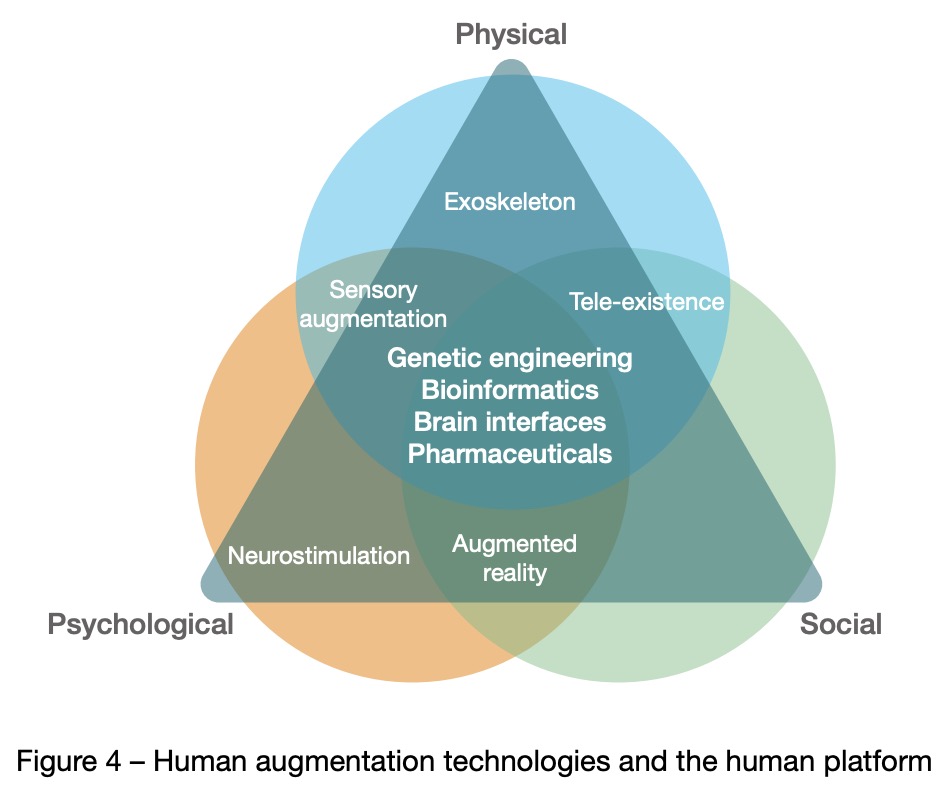
Biometric Privacy Acts in Few States: Needs to Go Federal
Unless you’re looking for it, most people probably aren’t even aware that there are biometric privacy laws in place in a handful of states, as well as a federal bill that was introduced in 2020. Though the federal bill died in Congress, it could still be re-introduced if people speak up.
The National Biometric Information Privacy Act of 2020 was introduced in August and died in Congress, having not received a vote. It would have required covered entities to obtain consent prior to capturing biometrics, and impose retention, disclosures, and destruction requirements, as well as include a private right of action.
There are several states with varying laws around privacy when it comes to biometrics. Surprisingly, Illinois has a pretty bold one in place, which has resulted in numerous class actions suits against biometric predators, such as the recent case against Facebook with a federal court approval of a $650 million settlement. The Illinois Biometric Information Privacy Act (BIPA) requires private entities to inform people in writing that their information is being collected and stored, what the purpose is, and term for collection and storage, and must secure a written release from the person. Those same private entities are not allowed to sell, lease, trade, or profit from a person’s biometric information. A person may file suit at $1,000 for each negligent violation or $5,000 for each intentional or reckless violation, plus attorneys’ fees and costs. Actual harm is not required to establish standing. There are a lot of lawsuits and class action suits in the works right now.
Texas and Washington states have laws stating that a person may not capture a biometric identifier without prior consent, nor can they sell biometric data without consent unless allowed by law, and must destroy the information within a reasonable time. However, neither state allows for a private right of action, meaning people cannot sue. The state attorney general is supposed to enforce these laws.
New York and Maryland have both introduced bills this year that would require written consent and prohibit the sale of that information. They would also allow for a private right of action. However, New York’s is sitting in committee and Maryland’s shows it was withdrawn by sponsor. That said, New York has a statute covering biometric information in their SHIELD Act which requires notification to individuals upon discovery of unauthorized access to their private information. Arkansas has the same breach of information law in place. Neither of these prevent the use of biometrics, so they’re not a huge comfort.
If it’s not crystal clear by now, globalists and eugenicists (sometimes one in the same) are running the show, and they are working very hard at achieving their ultimate desires of a controlled human race, evolution of transhumanism with a strong artificial intelligence taking the place of many humans, while they fly to Mars during their years of immortality, and observe humanity through endless surveillance systems. But their dream only becomes a reality if people allow it to.
Additional Information:
Eugenics, Infertility & Population Growth Crisis – 6-part series by Corey’s Digs which includes an extensive timeline on eugenics evolution dating back to the late 1800s, and those involved.
Recap of Key Implementers and Supporters Identified in This Series
The below list combines and expands on the list from Part 3 to include all of those in Part 4, totaling 287 names and companies. Note that many of the coalitions and alliances have hundreds of partners that may not have been covered in this series, so the number is quite larger than the list below. Don’t let it intimidate you. They are only has powerful as we allow them to be.
Accenture
Adyen
Akamai Technologies
Algoran
Alibaba Group
Alliance for Innovation Regulation
Amazon
Apple
Archer Daniels Midland
Argo Blockchain
AT&T
Audi
Australian Aid
Axoni
Baidu
Bancorp Bank
Bank for International Settlements
Banorte
BanQu
Barack Obama
Barclays
Beijing Genomics Institute (BGI)
Belt and Road Initiative Blockchain Alliance
BetterPlace Safety Solutions
Bezos Family Foundation
BiChip
Bill & Melinda Gates Foundation
Binance
Bitcoin
Bitcoin Latinum
BlackRock
Blockchain Founders Fund
Blockchain in Transport Alliance
Blockchain Industrial Alliance
Blockstack
BLOK Bioscience
BMO Harris
Boeing
Bolt
Bosch
British Standards Institution
Bunge
ByteDance
Carbon War Room
Cardano Foundation
Cargill
CARIN Alliance
Center for Global Development
Central Bank of Canada
Central Bankers
Central Banks U.S.
Charles Lieber
Chemonics International
China Academy of Information and Communications Technology (CAICT)
China Development Bank
China Electronic Standardization Institute
China Electronics Technology Group Corp
China Mobile
China National GeneBank
China Telecom
China Unicorn
China Unionpay
Circle Internet Financial
Cisco
CISCO
Citi
Clear
Clinton Foundation
Coalition for Epidemic Preparedness Innovations
COFCO
Coingeek
CoinShares
Collins Aerospace / Raytheon
CONA Services
Consensys
Continental
COVAX
Crypto Climate Accord
Curv Inc.
DARPA
David & Lucile Packard Foundation
David Ehrich
Deloitte
DENSO
Depository Trust & Clearing Corporation (DTCC)
Deutsche Bank
Digital Container Shipping Association
DizemeID Foundation
DMG Blockchain Solutions
Elon Musk
Emurgo
Energy Web
Enterprise Ethereum Alliance
Entrust
EOS Products
Equifax
Esri
Ethereum
European Blockchain Partnership
European Central Bank
European Commission
European Union
Evernorth
Evernym
Evrythng
Fabrick
Federal Reserve
Federal Reserve Banks
Fondation Botnar
Ford
Ford Foundation
G7
GAVI
Gavi
General Motors
George Church
George Soros
Glencore Agriculture
Global Compact
Global Covid Certificates Network (GCCN)
GoCardless
Goldman Sachs
Google Pay – Google Plex
Governments (many)
Grid Singularity
Gryphon Digital Mining
GS1
GSMA
Harvard University and Medical School
HERE
Hewlett Packard
Honda
Huawei
Hyundai
IBM
ICAP
ID2020
ID4D
IDEO
Illumina
In-Q-Tel
Industrial and Commercial Bank of China
InfoCert
Institute of Electrical and Electronics Engineers
Intel
Intelligence Advanced Research Products Activity
International Air Transport Association
International Federation of Surveyors
International Finance Forum (IFF)
International Monetary Fund
International Monetary Fund (IMF)
International Organization for Migration
International Organization for Standardization (ISO)
International Telecommunication Union
International Trade Center
IOHK
Jack Ma
Janet Yellen, Secretary of the Treasury
Jeff Bezos
Jeffrey Epstein
Jerome Powell, Federal Reserve Chair
Jim Yong Kim
Jo Ann Barefoot
Johns Hopkins Center for Health Security
JP Morgan Chase & Co
JPMorgan Chase
Justin Locke
Kristalina Georgievain
Lemann Foundation
Liink Blockchain
Linux Foundation
Lloyds Banks
Louis Dreyfus Company
Macola
Marc Benioff
Mark Zuckerberg
Mastercard
Max Levchin
Mayo Clinic
McKinsey & Company
Medici
Mercedes
Microsoft
MIT
MITRE Corporation
Mitsubishi
MOBi
Mobility Open Blockchain Initiative
Monetary Authority of Singapore
Monzo
Morgan Stanley
N26
NASA
National Academy of Science
National Institutes of Health
National Science Foundation
National Security Commission on Artificial Intelligence
NATO
NEC
Neuralink
NortinLifeLock
NTT
Oak Ridge National Laboratory
Omidyar Network
Open Geospatial Consortium
Oracle
Organization for Economic Co-operation and Development (OECD)
Outlier Ventures
PATH
Paypal
Peter Thiel
Pioneer
Plus Multiple Governments and government arms/agencies
Pope Francis
R3
RChain
Red Date Technologies
Reid Hoffman
Revolut
Richard Branson
Ripple Labs
Robert Wood Johnson Foundation
Rockefeller Foundation
Rocky Mountain Institute
Roman Catholic Church
Salesforce
SAP
shell
Siemens
Signature Bank
Simprints Technology
Skyline Renewables
SoFi
SoftBank
Solana
Sovrin
Square
Standard Chartered
Stanford Federal Credit Union
Starlink, SpaceX
State Information Center of China
Steel Partners
T-Mobile
Tencent
Texas A&M Transportation Institute
The Commons Project
The Good Health Pass Collaborative
Tiger Global Management
TikTok
Tom Steyer
Toyota
UC San Diego Health
UGS Technologies
UK Dept. of International Development
Ukaid
UNICEF
Unilever
United Nations
United Nations and its many arms
United Nations Framework Convention on Climate Change
UPS
USAID
UT-Battelle LLC
Vaccine Credentials Initiative (VCI)
Vancrypto
Vanguard
Varo Bank
Varo Money
VCI
Venmo
Verizon
Visa
Vy Capital
Walmart
WeBank
WebBank
Wellcome Trust and Wellcome Leap Fund
Wells Fargo
Wise
World Bank
World Economic Forum
World Food Programme
World Health Organization
ZTE
Zurich
HARD STOP. It’s Time To Man Up

We’ve already allowed them to lay the tracks. It’s time to dismantle them and start making a real impact at thwarting their agendas. It can be done. We are not their guinea pigs or human experiments – it’s time to act like it. Below are some key things you can begin doing immediately. Every single thing you do, every choice you make, and every action you take either drives this train forward or derails it. At times it will feel like an uphill battle. Empower your mind, body, and soul and use that force of life within you to shift the future. Together, we can bring the power, the strength, and the love it’s going to take to build the future we want – not the one they’ve “reimagined” for us.
• Do not be coerced, bribed, blackmailed, shamed, guilted, manipulated, or intimated into complying.
• Vaccine ID Passports, digital identities being pushed by banks, driver’s license facilities, and other industries as a means for “access” or “convenience” should be avoided at all cost.
• Make everyone you know aware of what this QR code and digital identity is really about, and how they intend to put you on the Blockchain to surveil and control your every move.
• Bringing this information to the attention of your legislatures and demanding legislation to block vaccine id passports and digital identity applications is critical. See part 1 for states who have already taken action on this front. There could be additional legislation in place since part 1 published.
• Remove your money from the large banks into smaller, family-owned banks and small credit unions. If 10% of people did this, it would create a huge shift.
• Build your own family or community energy and food systems. Resilient energy and food supplies will go a long way against their digital financial blackmailing systems.
• Stop feeding the beast – do not spend money at Amazon (here’s why), big box stores, and big brands that are building the infrastructure to enslave humanity. Here are some good alternative options.
• CASH IS KING. Use cash as often as possible, to avoid the hyper-tracking taking place inside bank accounts that are aggregating your data and building your social and climate score, as well as studying spending behaviors of the masses to manipulate industries, supply chains, and markets. Plus, they won’t earn fees off of you every time you swipe.
• Purchasing any products with the word “Smart” in it, isn’t so smart. These products are all used for surveillance purposes via audio, some visual, and data aggregating, not to mention potential integrated mind control technologies. Here is a checklist of tips for how to better protect yourself when it comes to technology.
• Here are 5 ways to financial security while building thriving communities outside the system.
• Clear as many debts as you are able to so you are beholden to no one. Invest in people, learning trade skills, family and community, hard assets, proper schooling for your children which might mean a local homeschool network, local farmers, any necessary supplies or equipment you feel you need, your health and peace of mind.
• If your place of employment is requiring you to get the injection, here are some resources, assistance, and a downloadable form to provide to your employer. If they will not accept a religious or medical exemption, and leave you with no option, let them fire you instead of quitting, so you have recourse.
• “The power of intention” is not a slogan or something to laugh about. It is indeed powerful. It doesn’t matter what location you are standing in, in relation to the world, the intention within your thoughts can be projected with no physical boundaries. Direct intention manifests itself as electric and magnetic energy that produces an ordered flux of photons, operating as coherent frequencies capable of changing the molecular structure of matter, alter the environment, heal illness, affect another’s thoughts and actions. It is that powerful. This has been proven thousands of times. Find a space in nature or in your home and spend 15 minutes a day focusing on your intentions, visualizing them, seeing them fully heal the world and shift the future in a positive direction. This can easily be done while on a walk as well. Trust in yourself – you are a powerful being.
If just 10% of the US population stuck to this list of bullet points above – we could forever shift the trajectory of their agenda and potentially put a halt to it.
This complete 4-part report, plus 22 ways to stop the vaccine ID passport, is now available in paperback! You can purchase the BOOK here.

Additional information
Doctors for Covid Ethics Symposium Part 1: The False Pandemic
Doctors for Covid Ethics Symposium Part 2: The Going Direct Reset
The “Going Direct” and Covid timeline parallel
This report was researched and written by Corey Lynn of Corey’s Digs for The Solari Report.

Subscribe to Corey’s Digs so you don’t miss a dig!






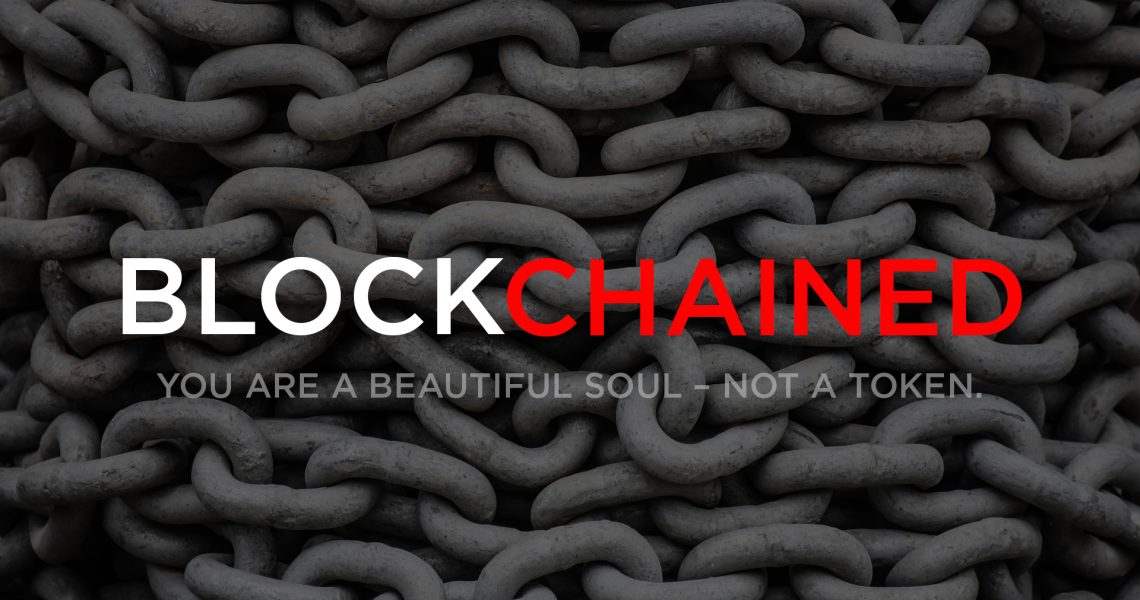

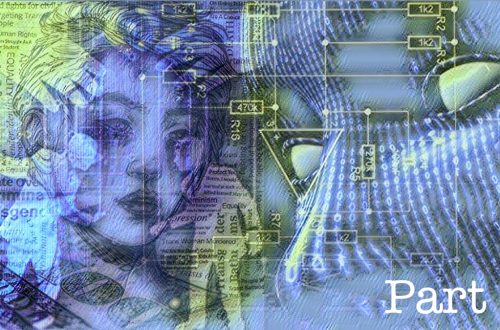


21 Comments
Jo Patti
Excellent and thorough article clearly explained. A must read for everyone especially policy makers, medical professionals and those who value freedom of thought, movement and expression. Bravo Corey-brave!
Robert E. Schoenle
The Future Revealed
We are nearing the end of the USA as we have known her! This should be obvious to anyone familiar with history and the fall of great world nations of the past. Alexander Tytler, a Scottish history professor at the University of Edinburgh during the 18th century, has often been credited for saying: “A democracy is always temporary in nature; it simply cannot exist as a permanent form of government. A democracy will continue to exist up until the time that voters discover that they can vote themselves generous gifts from the public treasury. From that moment on, the majority always votes for the candidates who promise the most benefits from the public treasury, with the result that every democracy will finally collapse due to loose fiscal policy, which is always followed by a dictatorship.” Tytler and others are also credited for declaring the following: “The average age of the world’s greatest civilizations from the beginning of history, has been about 200 years. During those years, these nations always progressed through the following sequence: 1. From bondage to spiritual faith; 2. From spiritual faith to great courage; 3. From courage to liberty; 4. From liberty to abundance; 5. From abundance to complacency; 6. From complacency to apathy; 7. From apathy to dependency; 8. And from dependency back into bondage.” A study of the rise and fall of great nations in the past appears to confirm it is so. Thus, it seems the USA has reached the seventh step of this sequence.
The majority of the citizens of the USA and their political leaders seem to have forgotten that the USA was founded upon the Judeo/Christian principles and teachings found in the holy Scriptures. Therefore, history will soon repeat itself and the USA will be judged by God and destroyed by Russia during World War III (Ezek. 39:6-7) in the fall of 2022. Prior to that, the prophetic significance of the Feast of Trumpets will be fulfilled with the Rapture on September 9, 2021 (Lev. 23:23-25; Jn. 4:35; 14:1-3; 1 Cor. 15:51-57; 1 Th. 4:13-18; 2 Th. 2:1; Ti. 2:13; 1 Jn. 3:1-3; Rev. 3:3, 10-11; 22:7, 12, 20). The Lord Jesus declared, “Verily I say unto you, This generation shall not pass (Mt. 24:34a; Mk. 13:30a; Lk. 21:32a) away (Lk. 21:32b), till all (Mt. 24:34b; Mk. 13:30b; Lk. 21:32c) these things (Mt. 24:34c; Mk. 13:30c) be fulfilled (Mt. 24:34d; Mk. 13:30d; Lk. 21:32d).” The generation that will witness His Advent to earth began with the rebirth of the nation of Israel on May 14, 1948 (Mt. 24:32-33; Mk. 13:28-29; Lk. 21:29b-31g). Since we are now in the early months of the year 2021, this must be a generation of eighty years (Ps. 90:2, 10), which will end with the Second Coming of the Lord Jesus Christ to planet Earth on the Feast of a Day of Atonement [Yom Kippur] (Lev. 23:26-32) on September 30, 2028. The horrendous twenty-one judgments of God upon a Christ-rejecting world are described in Revelation 6:1-19:21. They will begin with the signing of a seven-year [2,520 days] (Dan. 9:27; Rev. 11:3; 12:6) defense treaty between the leader of the EU [Antichrist] and Israel in May 2023 and be fulfilled on September 30, 2028 (Mt. 24:29-31; 25:31-46). Thus, we are now living in the period of time the Lord Jesus described as the beginning of sorrows (Mt. 24:4-8).
A complete explanation of all the above warnings and much more may be found, read and confirmed in A Biblical View of the Past, Present, & Future on http://www.endtimewarnings.org. NOW is the appointed time (Rom. 13:11; 2 Cor. 6:2) Maranatha!
Edwin
DR.SCOTT MCQUATE IS THE TRUTH!!!
Btw:Thanks For The Report(*_*)
David Robertson
I thought the banks already ran the government. So the government running the banks adds up to the banks running the government running the banks running the government. It sounds a lot like a cat chasing its tail to me. In any event I honestly don’t care as I save outside the banking system with physical silver.
I am also on a pension so I am already hooked into the System for my pensions. However as soon as they pay me I use the surplus to buy silver and the rest goes to pay down my credit card that I use for everyday purchases. It is paid off every month to avoid interest charges. I don’t use cash and haven’t done so for years. I don’t own anything of substance and I am relatively happy. So I am probably a perfect example of the new digital citizen. I have often thought they may have used me as a template for their New World Order. Nevertheless I don’t have a QR code and I won’t sign up for one. I don’t wear a mask and I don’t consciously social distance but most of the time I rarely get near anyone. So in every other respect I live outside the System and always have done, from choice.
I can’t imagine why anyone would be interested in an old codger like me who is on his last innings and I frankly don’t understand the need to control everyone all the time everywhere and to pry into their personal affairs, if indeed this is what is happening. That sounds like a very boring existence, like watching paint dry. After all as Henry David Thoreau observed: “The mass of men live lives of quiet desperation” What does that tell us about those in charge, if they want to track us and control us? Honestly, if they succeed in their plans they will lead such boring lives they will all eventually blow their brains out. So perhaps the world WILL end with that bang and not a whimper. We can but hope.
David Robertson
P.S. I will never take the Jab, even if they cut off my pensions. I will not cooperate with Evil. I feel sorry for those who are losing their jobs on this account and most of all I am angry that they are Jabbing children even if their parents have not consented. Parents who do consent to their children being jabbed will live to regret their decison. Myocarditis, a side effct of the Jab, is a lifelong weakness of the heart that will result in premature death.
David Robertson
Alexander Fraser Tytler, Lord Woodhouselee (from Wikipedia):
“In his Lectures, Tytler expressed a critical view of democracy in general and representative democracies such as republics in particular. He believed that “a pure democracy is a chimera”, and that “All government is essentially of the nature of a monarchy”.
In discussing the Athenian democracy, after noting that a great number of the population were actually enslaved, he went on to say, “Nor were the superior classes in the actual enjoyment of a rational liberty and independence. They were perpetually divided into factions, which servilely ranked themselves under the banners of the contending demagogues; and these maintained their influence over their partisans by the most shameful corruption and bribery, of which the means were supplied alone by the plunder of the public money”.
Speaking about the measure of freedom enjoyed by the people in a republic or democracy, Tytler wrote, “The people flatter themselves that they have the sovereign power. These are, in fact, words without meaning. It is true they elected governors; but how are these elections brought about? In every instance of election by the mass of a people—through the influence of those governors themselves, and by means the most opposite to a free and disinterested choice, by the basest corruption and bribery. But those governors once selected, where is the boasted freedom of the people? They must submit to their rule and control, with the same abandonment of their natural liberty, the freedom of their will, and the command of their actions, as if they were under the rule of a monarch”.
Tytler dismisses the more optimistic vision of democracy by commentators such as Montesquieu as “nothing better than an Utopian theory, a splendid chimera, descriptive of a state of society that never did, and never could exist; a republic not of men, but of angels”, for “While man is being instigated by the love of power—a passion visible in an infant, and common to us even with the inferior animals—he will seek personal superiority in preference to every matter of a general concern”.
“Or at best, he will employ himself in advancing the public good, as the means of individual distinction and elevation: he will promote the interest of the state from the selfish but most useful passion of making himself considerable in that establishment which he labors to aggrandize. Such is the true picture of man as a political agent”.”
Kurt Anderson
Wow. Interesting times we are living in. Corey, you are the best investigative journalist out there. Thanks for all your hard work.
Tressy
Thank you for all you have done to inform us. Excellent hard work and I appreciate it all. I will keep sharing this and continue the fight. God bless 🙏✝️
Carol
I starting using cash on Fridays a few weeks ago. I’m actually using cash more days of the week now than debit cards. I am also a smoker, and until recently had been purchasing cigarettes every few days with a debit card, on what I had not realized was a regular schedule of cigarette purchasing. I’d had no idea how closely my cigarette purchase habits were being monitored until I’d started using cash for these purchases. Within a a very short time of switching to cash cigarette purchasing. I began receiving emails from Marlboro- containing discounts and “enter to win” type offers. Shorty after that, $1.00 off per pack coupons started arriving in the mail.
Following Corey’s work for over a year now, I spot this immediately for what it is. Doesn’t Bill Gates own tobacco companies? In the past I might’ve told myself I was only being paranoid at suspecting this cause and effect to be the result of careful monitoring and manipulation. Like when I say out loud in my own living room, “why don’t we move the sofa”. “Sofa sofa sofa” stated out loud a few times, then the creepy ads for sofas start following me around online a week later and I’d think “no, couldn’t be..” Yes, could be and is
Peter S
Very well researched series! I’m finding these very informative and helpful. I find it very telling that the linux foundation is being bank rolled to support this new regime. It just goes to show you, they want absolutely no alternative system that exists that doesn’t support this control system. They want ot make sure even the free alternatives support it, otherwise people could argue that we needed to maintain the old analog systems because of availability concerns for people who are less well off and can’t afford windows or apple laptops. I think this is also part of the reason why tehy want internet connectivity for all. They don’t want any excuse for people to be able to weasle out without explicitly saying they want no part of this bullshit.
On another note, I watched a video on youtube today which shows some of the crypto folk are starting to draw all the same connections that this thing was if not spawned intentionally to serve this agenda, then it has at a bare minimum been totally hijacked. It’s a short video and doesn’t go into as much depth as your articles, but I found it good as it covered some different points. https://www.youtube.com/watch?v=WCvKWF43snw
Arshan
“These people fundementally do not know what it is to be human. They are not qualified to augment anythning especially a being that cannot be augmented in the first place. – COSMIC SEER
Judy Brown-Stiles
Sooooo sorry I cannot donate on minimal disability income but please know I pray that God will bless your vital work with such magnitude that it will utterly sustain you and protect you from the preditors of this world trying to remove Him and destroy our country.Thank you for what you do!!!!!
Carol
Corey, I’ve found some easy chain of connections here that are right up your ally, with the way you connect the dots. This is very easy to do, if only we take a little time to do it. This story came out today with the headline NYT Confirms Biden Murdered Innocent Family In Kabul Drone Strike, found on ZeroHedge. The main target of the attack was a man named Zemari Ahmadi, 43, who had worked since 2006 as an electrical engineer for Nutrition and Education International, a California-based aid and lobbying group. The morning of the strike, Mr. Ahmadi’s boss called from the office at around 8:45 a.m., and asked him to pick up his laptop. 7 children were killed in the strike on Mr Amadi today. Here’s the easy connections and possible motivations to this murder that a little will do.
Nutrition and Educational International (the employer of the target of the military strike, Mr Amadi) here:
https://www.neifoundation.org/
Women Empowerment and Entrepreneurship (a term that screams Hilary Clinton where associated with a 503 c)
Nutrition and Education International is a non-partisan, non-profit organization based in Pasadena, California. NEI was formed in 2003 by Dr. Steven Kwon to fight widespread malnutrition among women and children who live in high-mortality areas in Afghanistan
Here’s a little about Dr. Steven Kwon
I am the founder and president of Nutrition & Education International (NEI), currently working to address nationwide Protein-Energy Malnutrition (PEM) especially among the women and children in rural Afghanistan through developing a full soy value chain as a practical solution to PRM.(and do the wealthy liberals sending money though this 503 c ever bother with the common sense question “now why wouldn’t the women and children in rural afganistan be able to supply their own nutrition, as they’ve done for thousands of years, and suddenly need Pasadena liberals todo it for them?)
Since 2003, I have been leading the overall direction of the organization in Afghanistan, Korea, and the United States. I am sensitive to misfortunes being experienced by the innocent and poor people due to on-going military conflicts in war-torn countries. NEI advocates for the empowerment of local staff and beneficiaries of Afghanistan to solve their poverty and food insecurity in a self-sustainable manner. I am inspired by NEI’s motto: “Can we help even one more Afghan family grow soybeans to fight malnutrition?”
Responsible for research and development of bio-ingredients and bio-flavors (meaning the flavor may come from the cell line an aborted baby- hence the term bio flavor) through microbiological and/or enzymatic modifications of food carbohydrates, lipids, proteins, and food stuffs such as eggs, coffee, and cocoa. Co-inventor of nine US and European Patents.
https://www.linkedin.com/in/steven-kwon-0090bb25
Dr. Steven Kwon, president of Nutrition and Education International, through his cultural advisor and interpreter (center), speaks to Gluam Said (right), the winner of the 2010 Afghan Farmer of the Year Award, during the inauguration ceremony for the Afghan Kapisa Soybean Farmers Association
https://picryl.com/media/dr-steven-kwon-left-president-of-nutrition-and-922d1f
The man killed in the US military drone strike in Afganistan, along with 7 children, worked for Dr. Steven Kwon and Nutrition and Education International, a Pasedna 503 c. While everyone is screaming Biden incomepetence on ZeroHedge, I beg to differ. This was murder and it was no mistake, it seems
https://www.zerohedge.com/geopolitical/nyt-confirms-biden-murdered-innocent-family-kabul-drone-strike
Damian
Thank you Corey (and team) for all of your invaluable work.
In my country it’s not mandatory to scan your Covid QR code through a smart phone, you can print it on paper and they will scan it thereoff. I know it’s not ideal, but when it’s hard to avoid in some cases, I guess doing that won’t put you on the blockchain right?
Jim
Thank you Corey for these series and all the great work.
Few comments:
– These reports would have been very helpful one year ago when we were looking for what was happening, the reasons and for solutions. It would have been very welcome at the time when the globalist vermin imposed force masking on the world. The world population lost the big freedom battle when they agreed to wear a muzzle without or very little fight.
– Part 4 is very long, of course it has to be comprehensive but who is going to tae the time to read it completely?
– Unfortunately, tyranny is never achieved by tyrants but by people obedience and they are a vast majority. I don’t think there are even 10% of us in the whole world to fight this agenda. Even many of those who oppose vax ID’s are happy to wear a muzzle when they go shopping. This is how ignorant and dumb the general population has become.
– The American people saw their elections being rigged on an obvious scale never seen before and they didn’t even move a finger (except for those on the 6th of January). 30 years ago, they would have burned congress and hanged demented pedophile biden!
It shows how decadent and spineless the US people have become. Land of the cowed and the slaves… it is fortunate that the federal system allows for State independence, otherwise the actual banana republic would resemble north korea or china.
– We are not fighting only the globalist scum but millions of compliant sheep… And they are key implementers/influencers after having been brainwashed.
– All the solutions you give in part 4 to fight their agenda are valid, but some are only valid for the USA. In Europe, there are no small family owned banks (unless you’re a millionaire) and very few ‘community credit unions’ (and they don’t have daily banning accounts but only savings accounts that can’t be used for daily needs). In some countries like Germany people can’t even have a well for their water use. So, getting out of the grid is difficult.
– We have been talking to everybody we could to warn them about the fake pandemic, the real agenda, the manipulations and the vaccine ID agenda. Most of them believe the lies of the MSM and corrupt governments, and those who feel we are right prefer to burry their heads in the sand as the truth would avoid them to sleep at night. We are dealing with a lot of ignorant, cowards and idiots who’d rather have their ids enslaved (or killed) than move a finger. This is the sad truth. Many of these morons are (were) friends or family.
– “Direct intention manifests itself as electric and magnetic energy that produces an ordered flux of photons”… In Star Wars maybe, but in the real world it doesn’t work. I have been trying to kill bill gates and others with my intentions since 2 years now and it doesn’t work…
– For the rest, we are prepared to lose jobs, live from our own made food and use only cash, but unless you put all your money out of the banks, there is no escape to it.
– You mentioned the rockfellers, gates, soros & co, but you haven’t mentioned their masters: the rotshchilds who are said to won all central banks in the world and the BIS in Basel. Why not exposing them as well, are they that invisible?
– Finally, all the solutions your provide are fine, but you fail to mention SABOTAGE. When they install 5G infrastructure to surveill and harm you in your area, you have no other choice but destroy it as they have done in the UK and Netherlands on a massive scale. Same for any of their IoT, Ai, and other tools of oppression. We have a right and a duty to destroy and sabotage their evil tools of control.
– We also have to go after them, physically. Peaceful protests, petitions and begging on our knees is what they want. Burning google, UN, WHO or any other vermin org HQ is what they fear. We must do what they fear. We also must retaliate against collaborators and hit the executives at the head of the fascist corporations on your list. We also can sabotage any of their assets.
– They fear us, they fear our numbers and our anger, and rightly so, no police or military force can stop a faithful, motivated and fearless People. the proof in Afghanistan. If their fathers didn’t succeed, their sons would. I don’t see this spirit in the West. I see only meak people easy to corrupt and manipulate or tame. I hope I am wrong.
If we stay docile, peaceful and compliant, they will succeed. Everything goes in a war for survival, it means that a bullet in the head of bill gates or fauci are worth 10 000 peaceful protests.
Americans have weapons, use them on the right targets for God sake!
jim
To Damian:
Either it’s on paper or digital is the same. As long as you have a QR code, you have become marked cattle. You see only a print on your side but they will register you in the system.
Why would you have a QR code anyway? Haven’t you read the article?
If you must travel or get a life saving operation: it is very easy to make fake certificates with fake QR codes and therefore inundate their systems with BS.
Otherwise, never, ever allow them to create a QR code.
Jim
Agree with you, parents who force jab their kids (because it is whta they do as children always want to please their parents and therefore submit to their wim) will regret it.
And when kids start to die massively, we will see another type of story.
But some people are so stupid that even after having assassinated their own, they still blame ‘covid’… This is where natiural selection makes sense. nature would never have allowed weaklings of this kind to survive anyway.
Flawedgem
Hello Jim,
Would you be willing to share how one aquires a “fake” QR code?
Thank you
AuburnTiger94
Well said Jim!!! 100% agree!
Cee
Very important information, thank you. However, Key Implementers and Supporters Identified in This Series is not the Roman Catholic Church as a whole. It is specifically certain key players in high places who have infiltrated the church throughout history. This distinction needs to be made.
Jeffrey Stokes
Absolutely good post, really i am proud of you. thanks for sharing